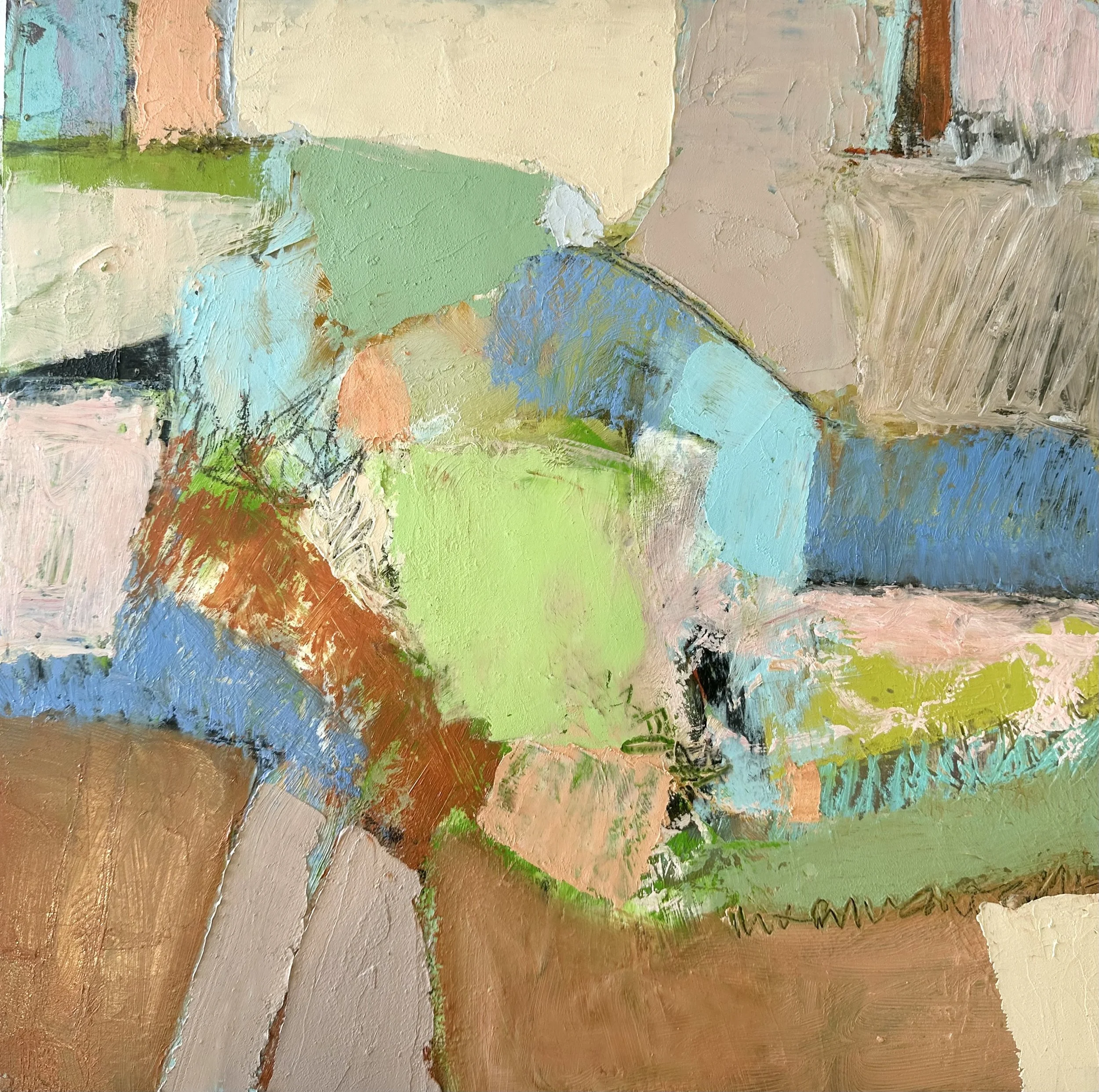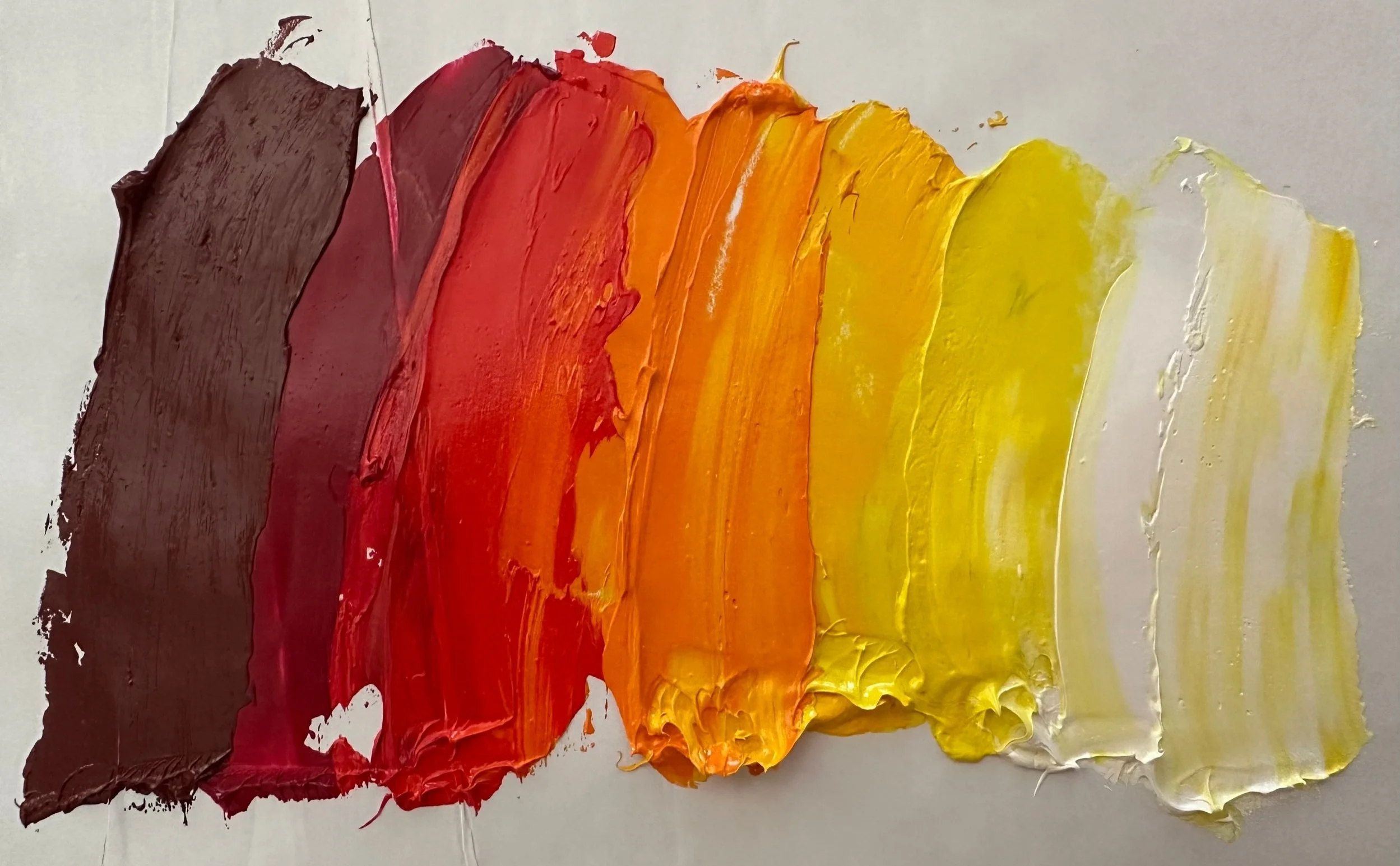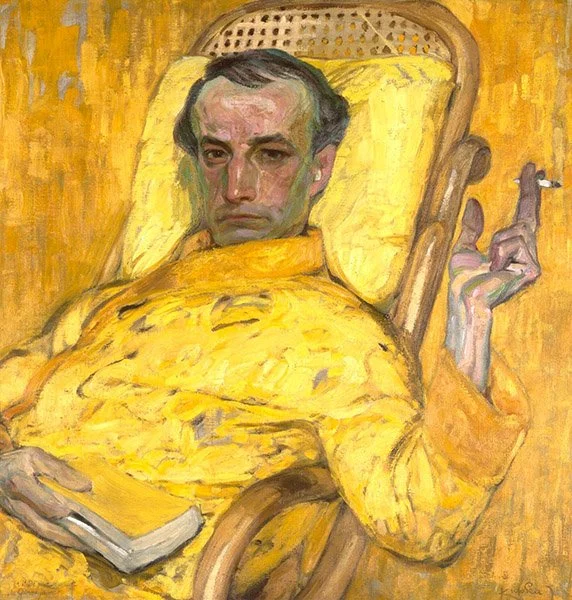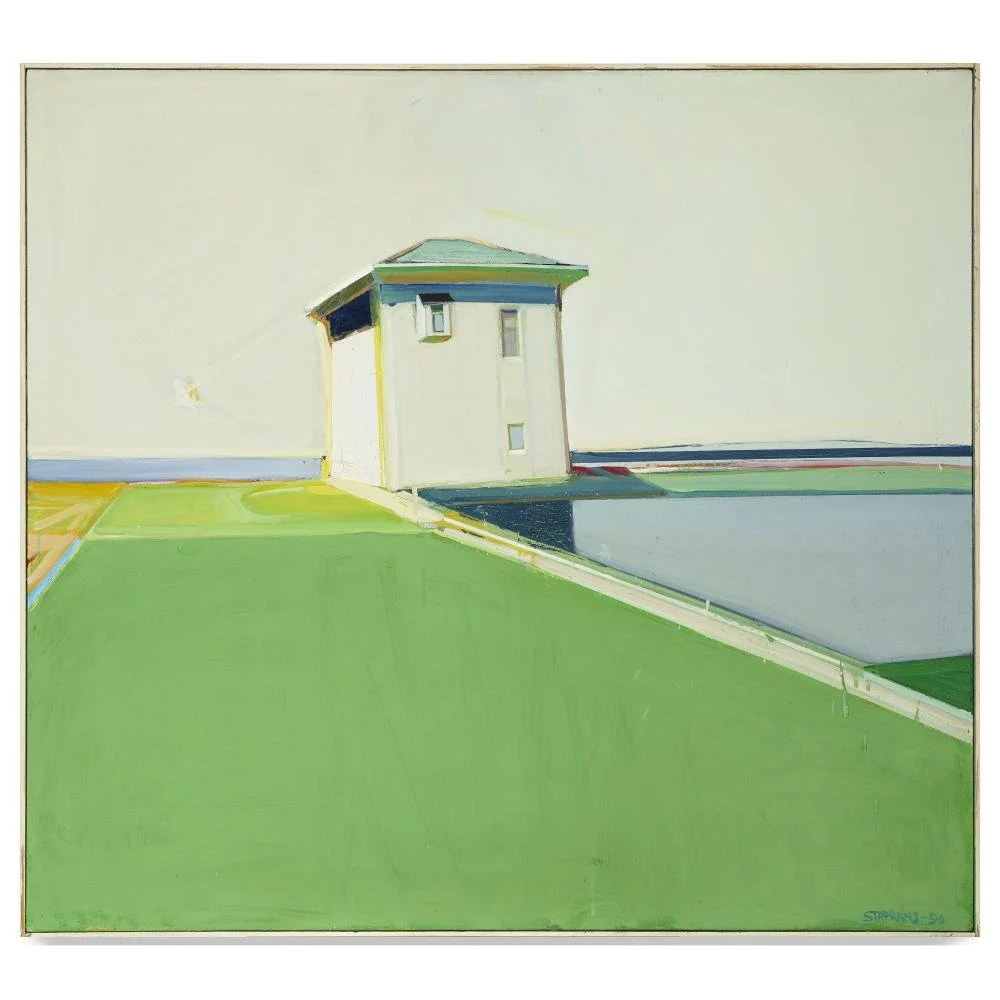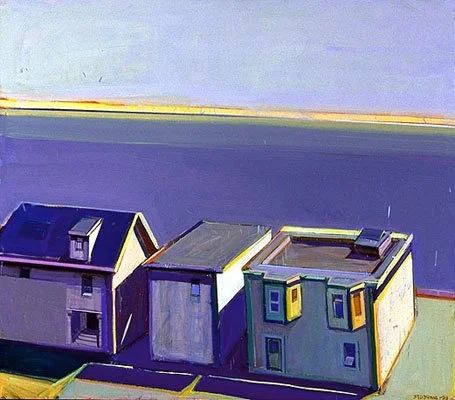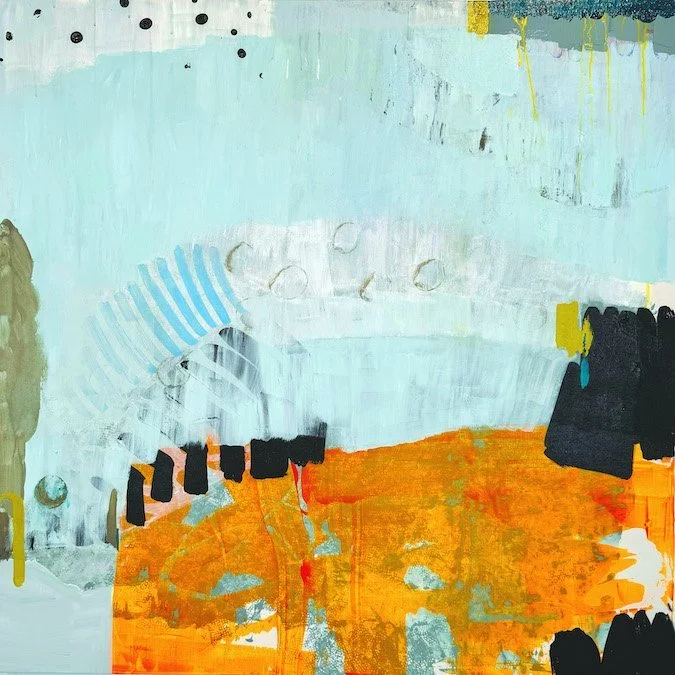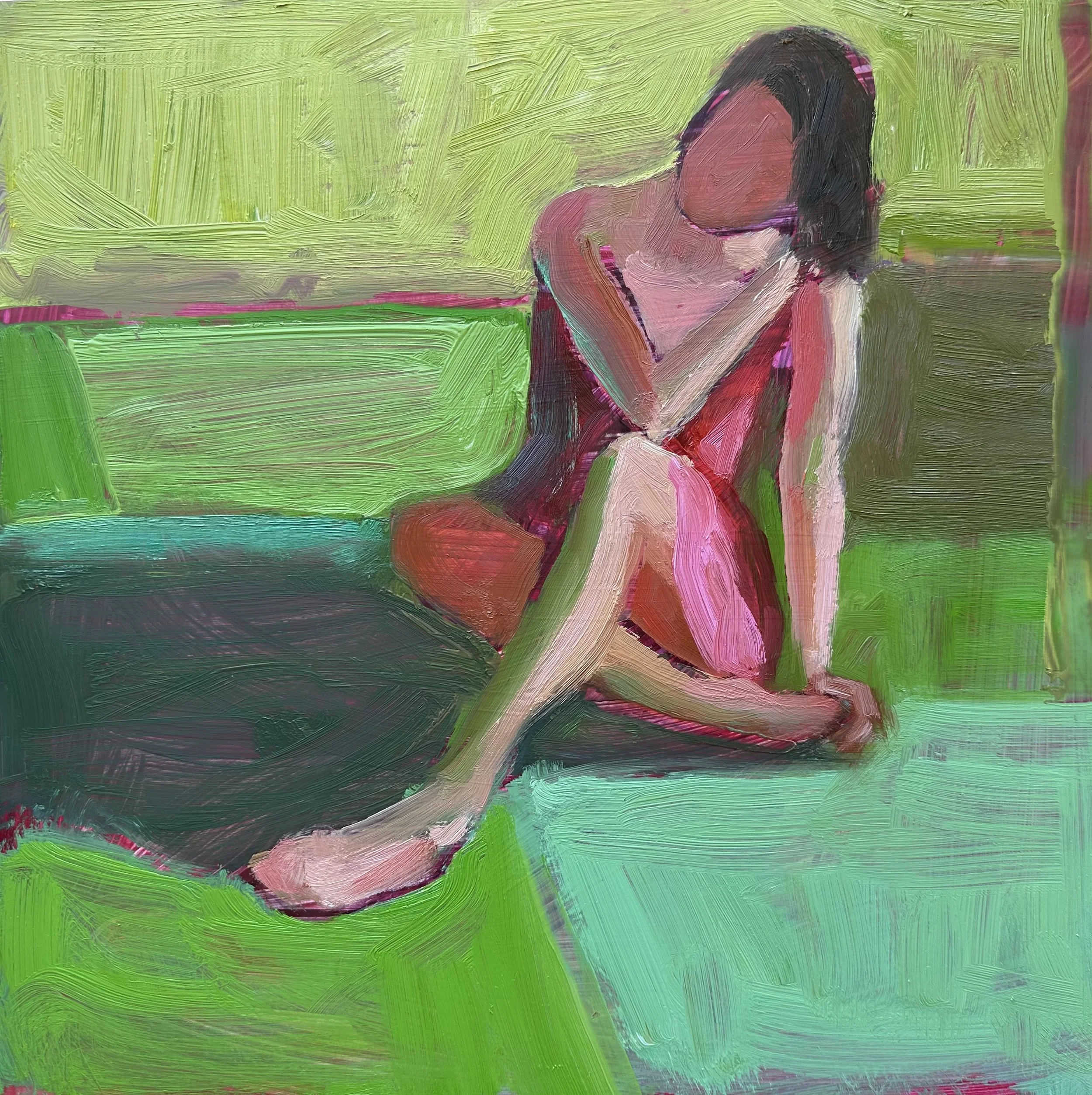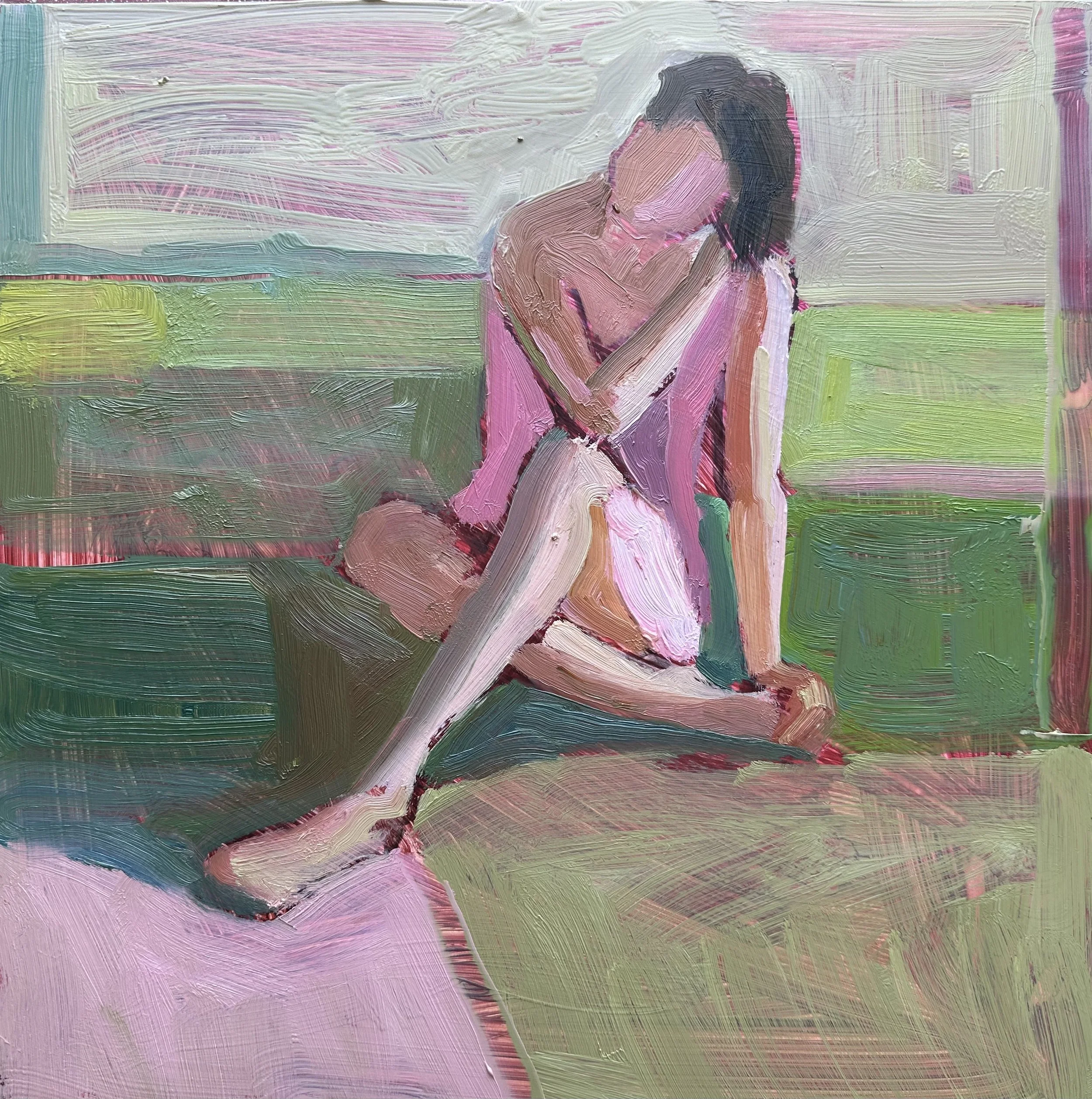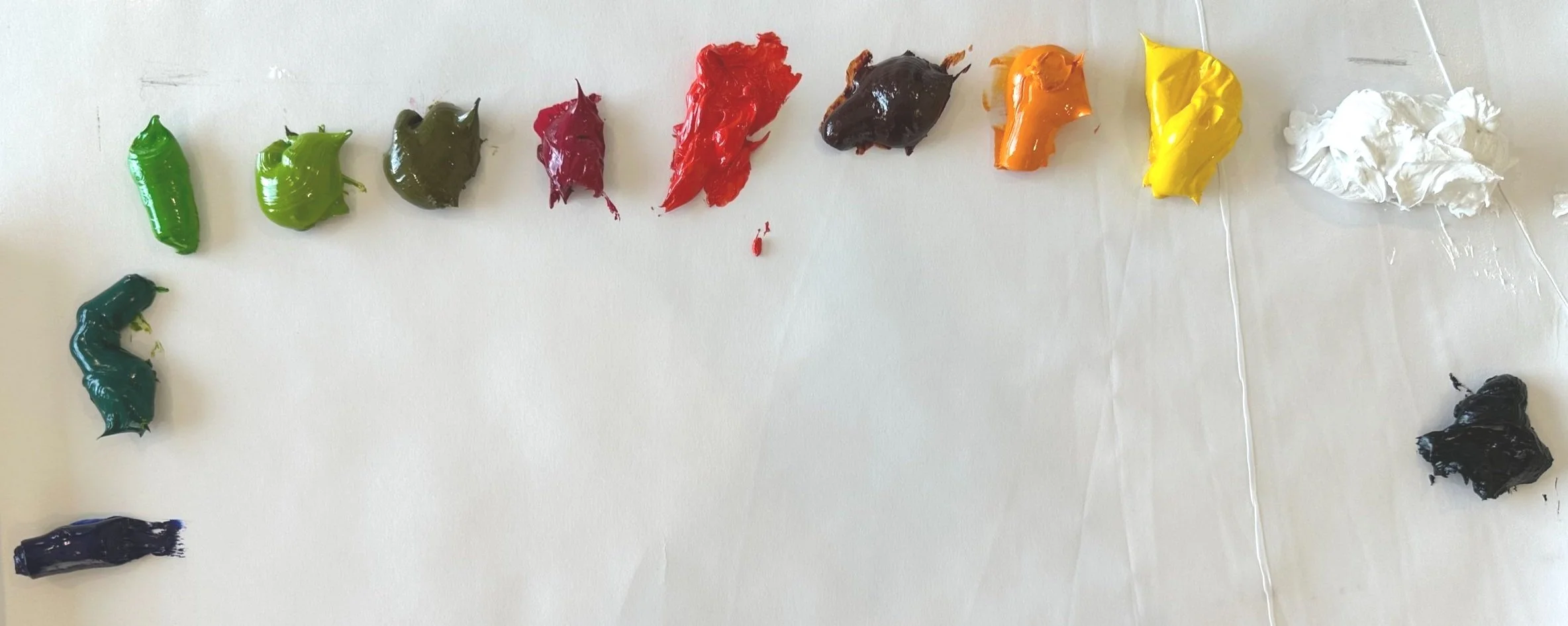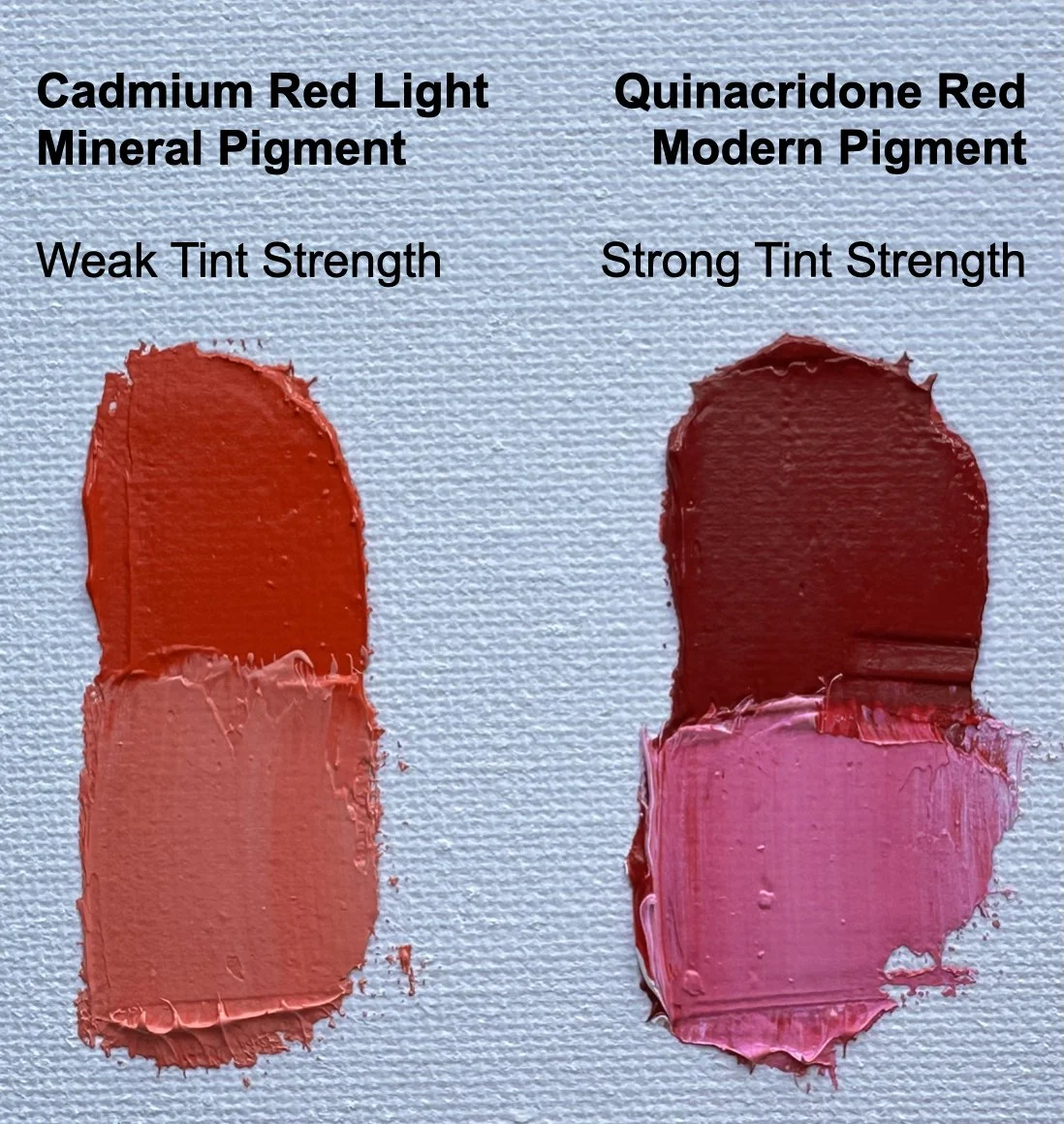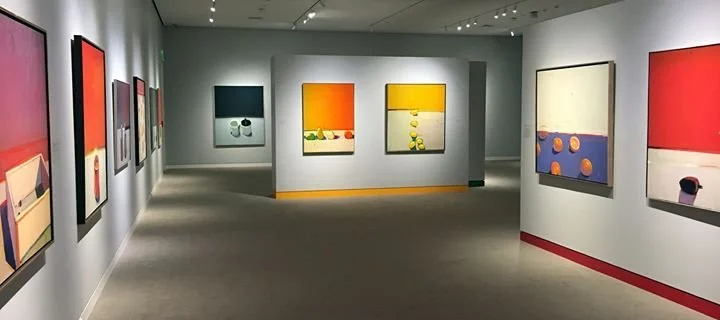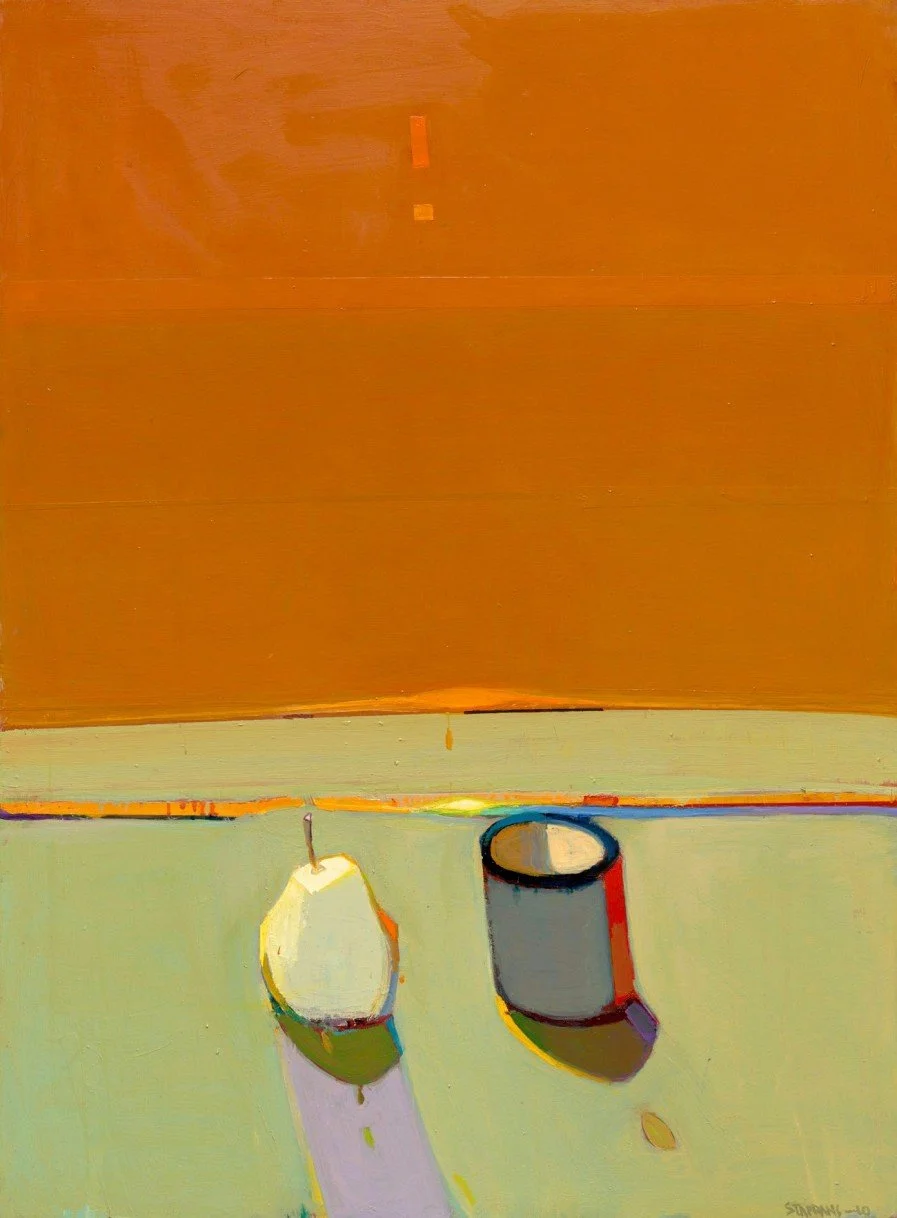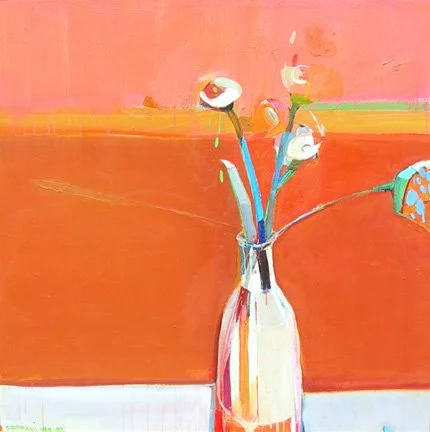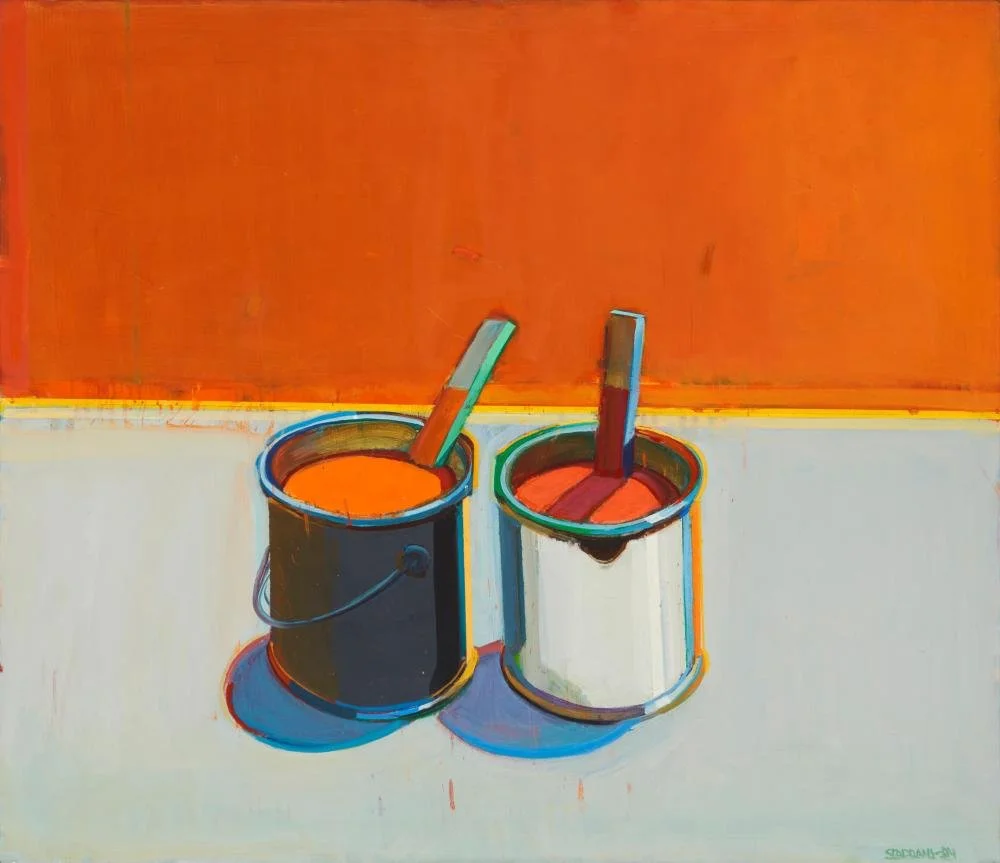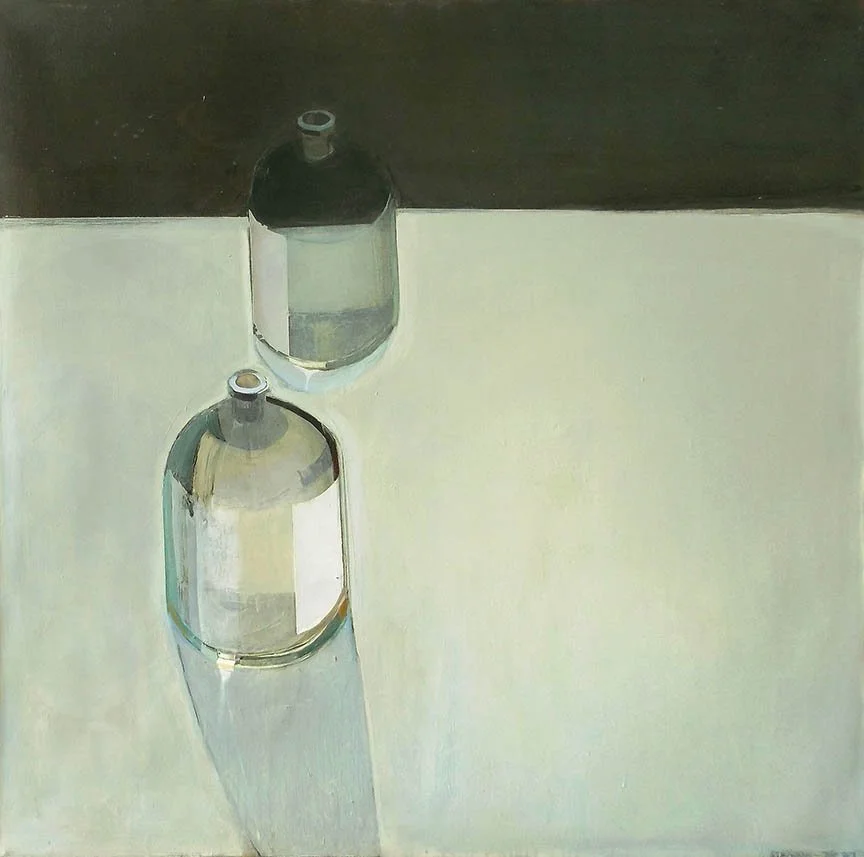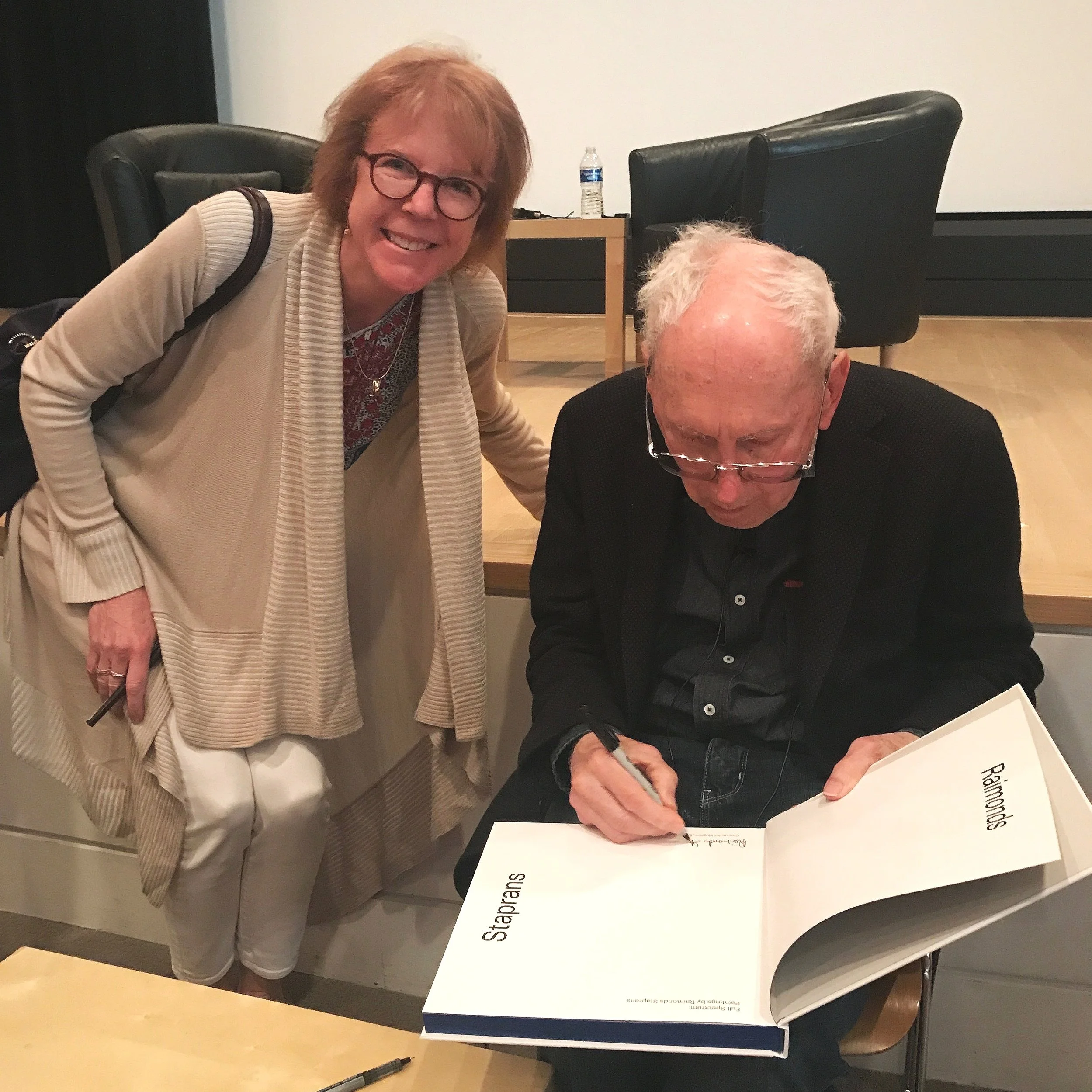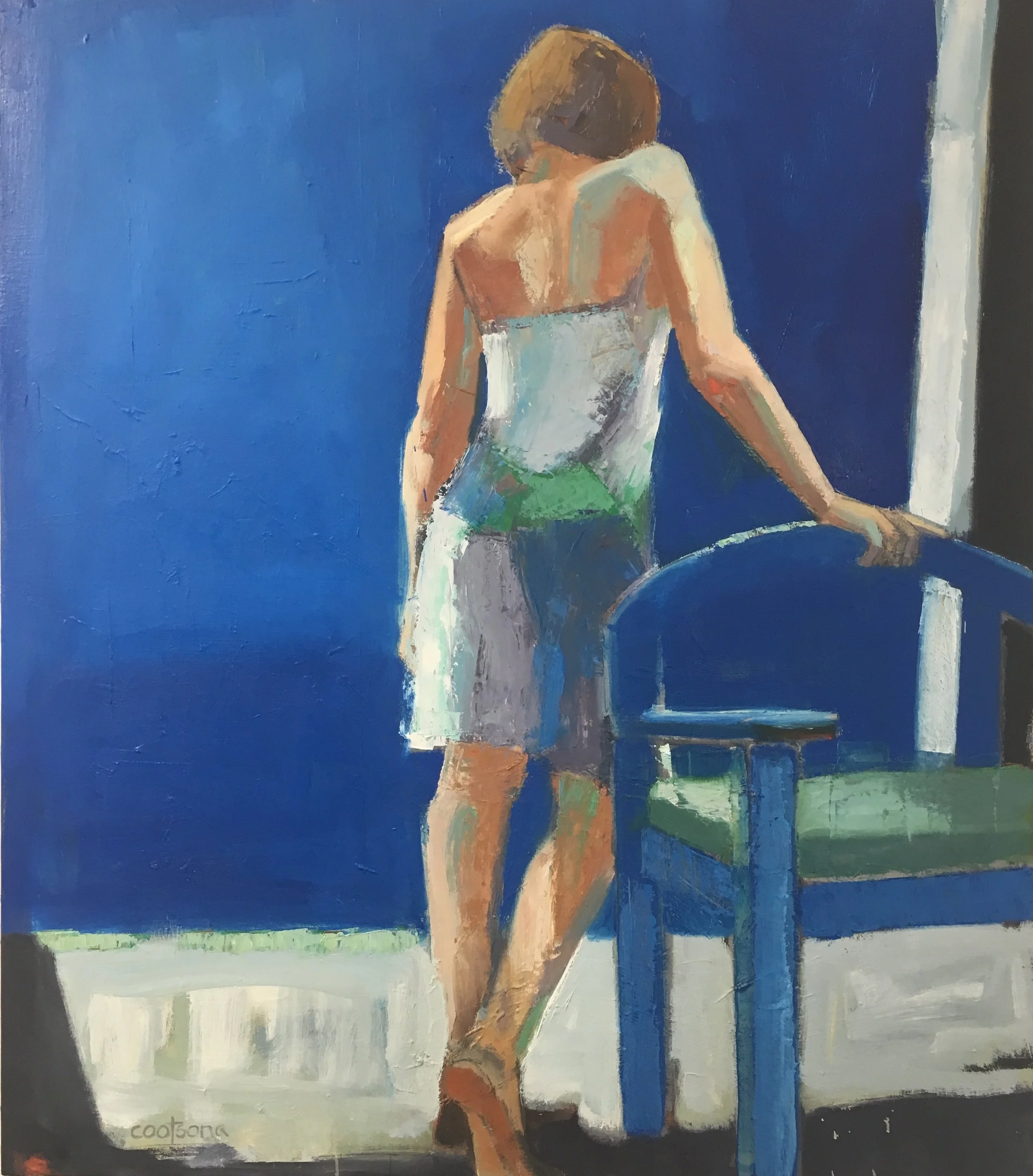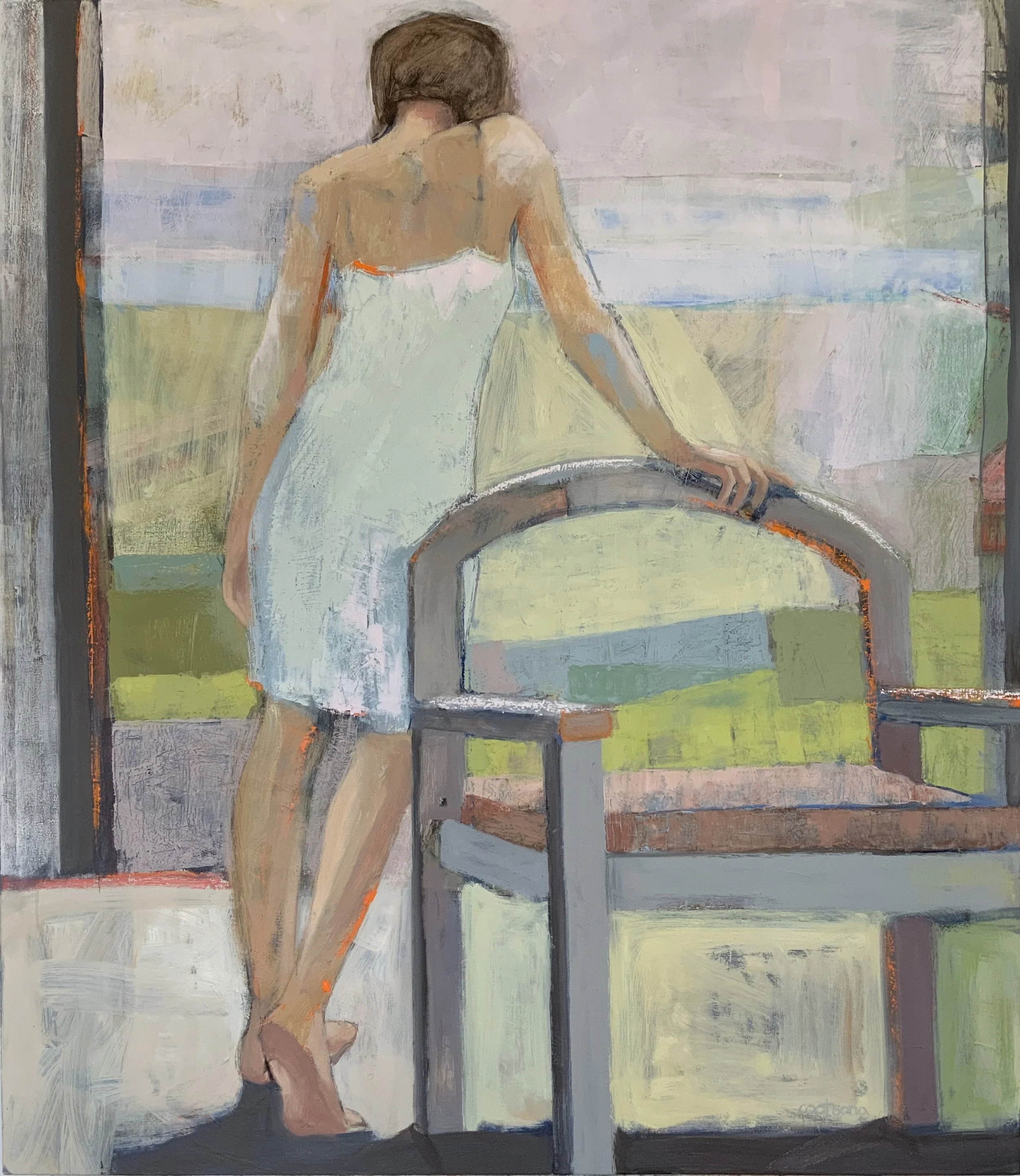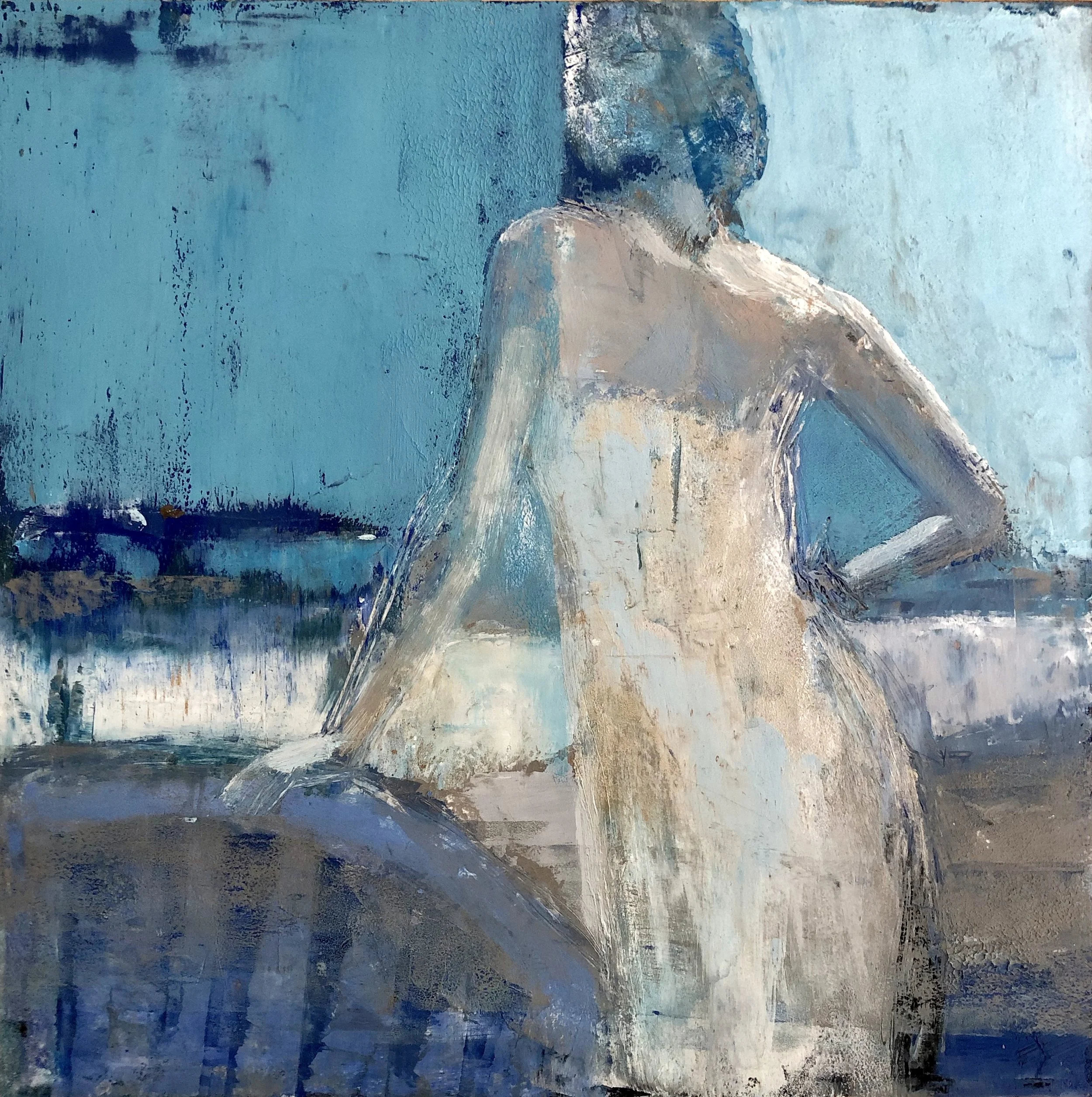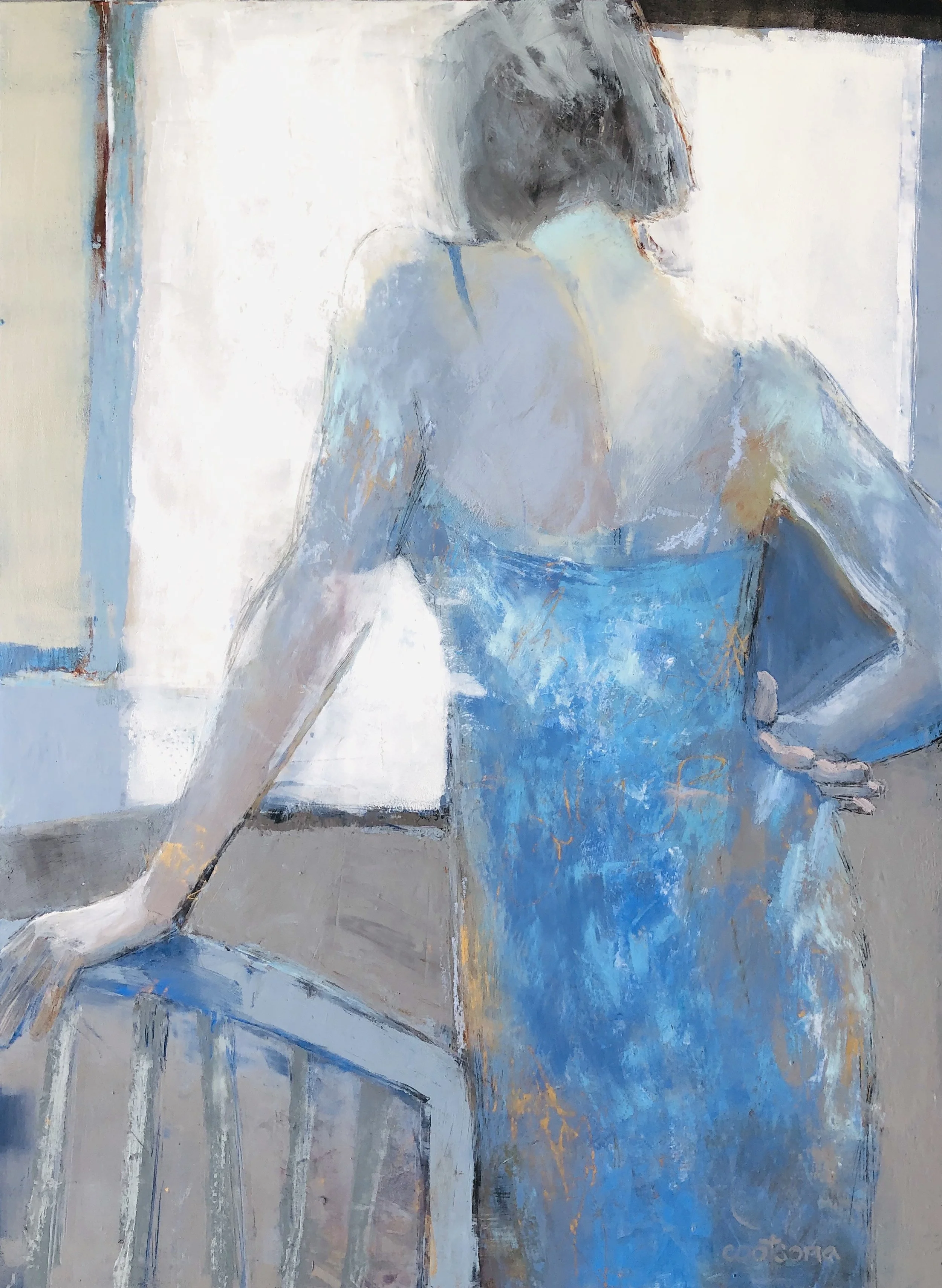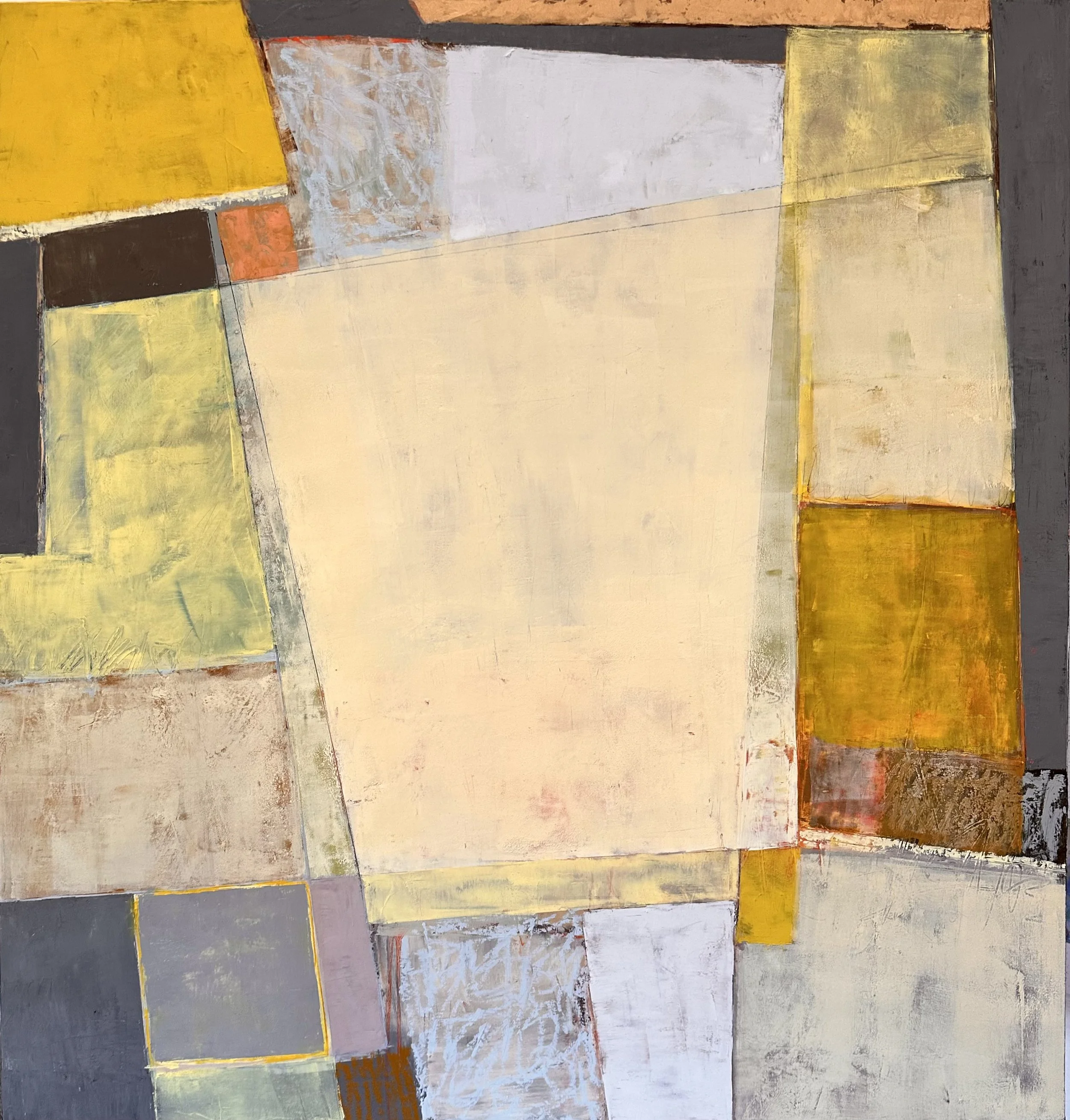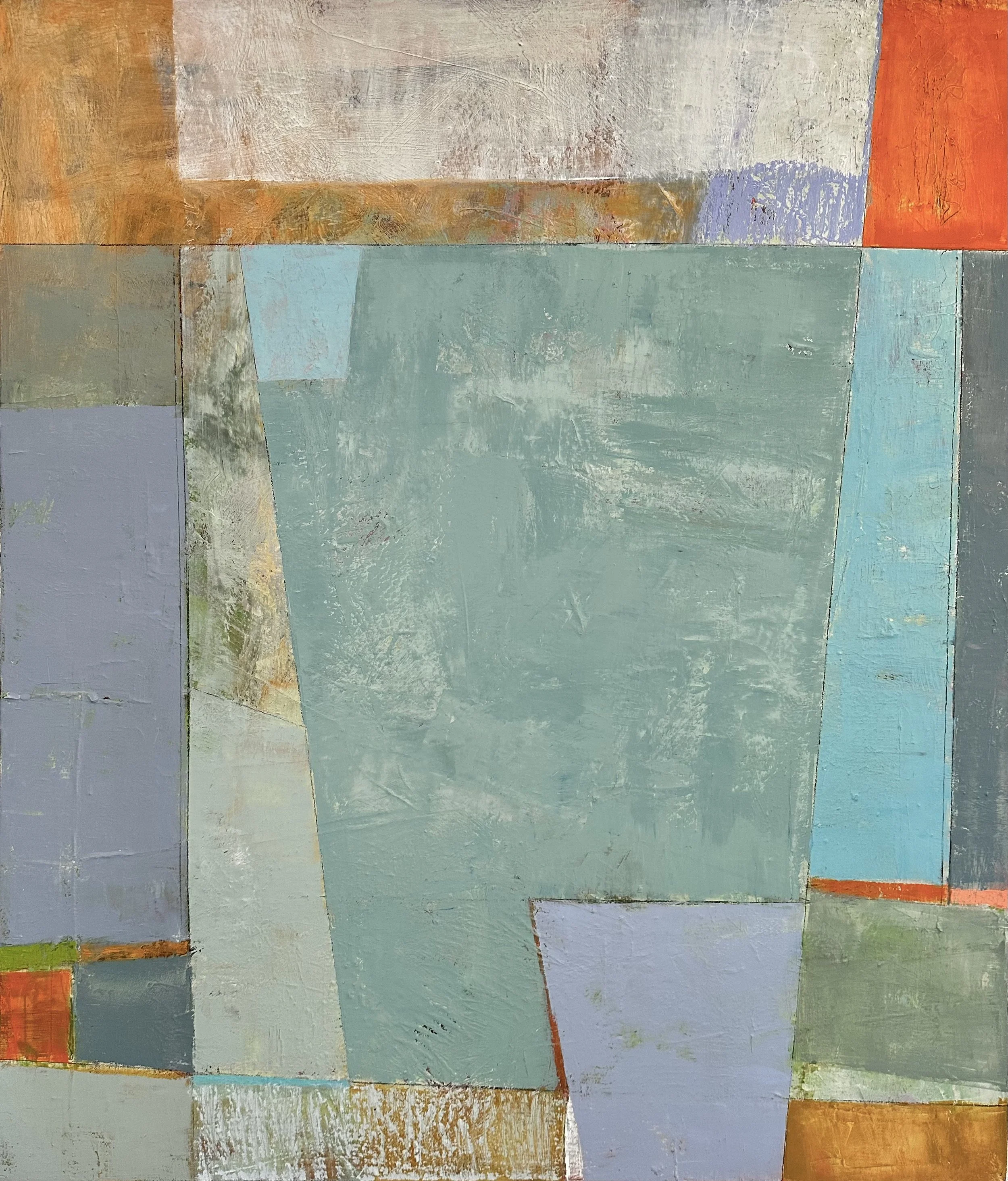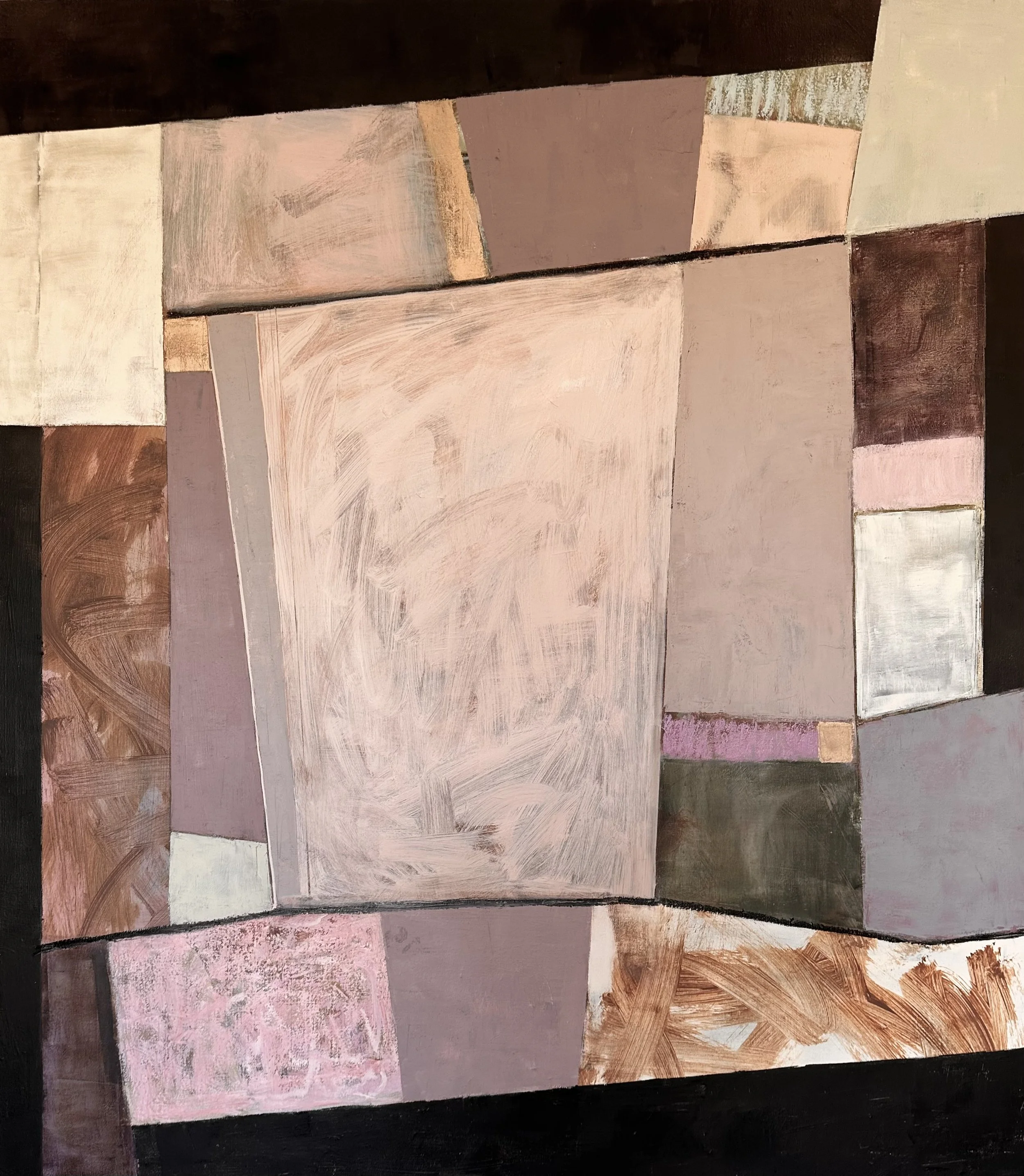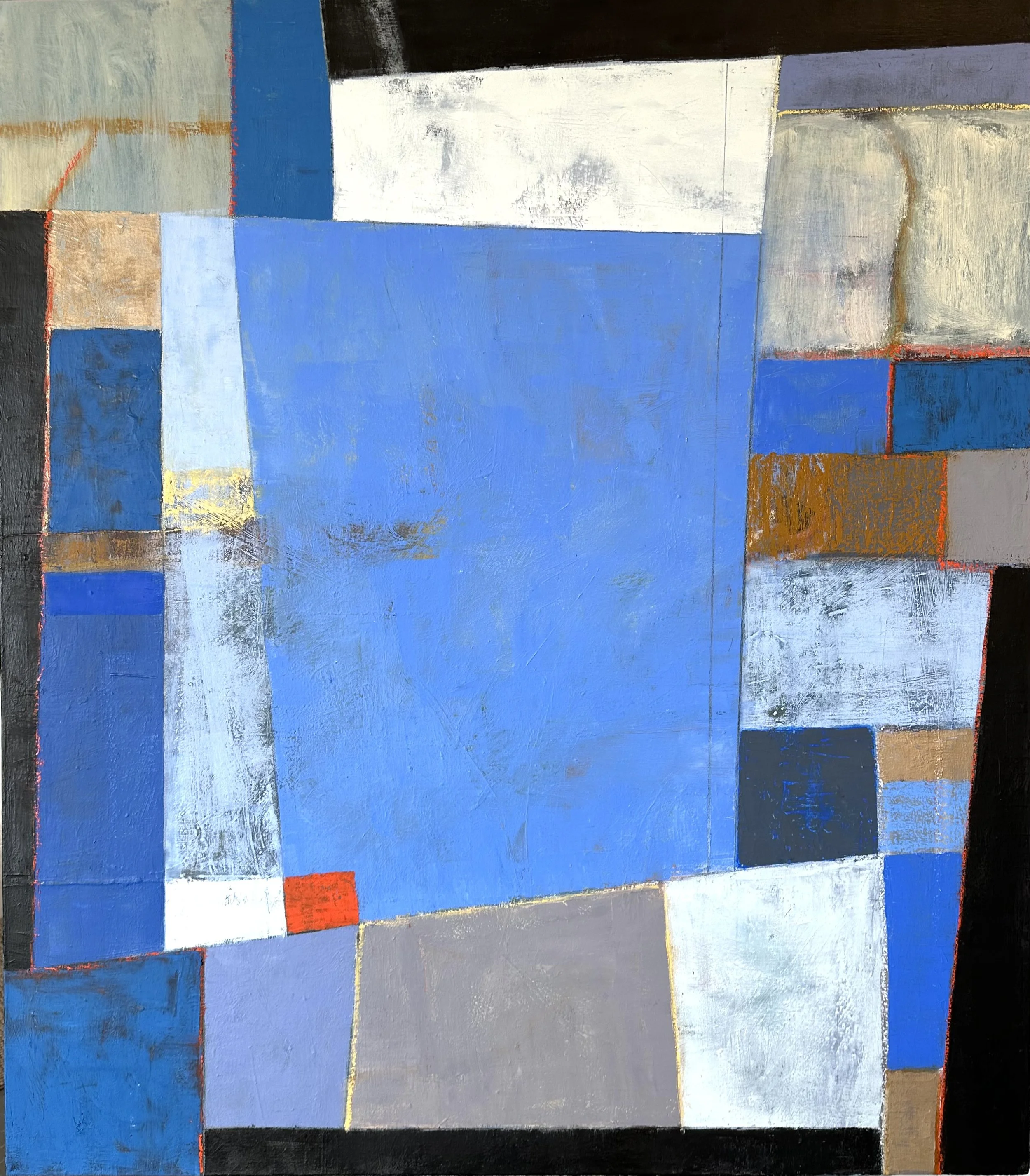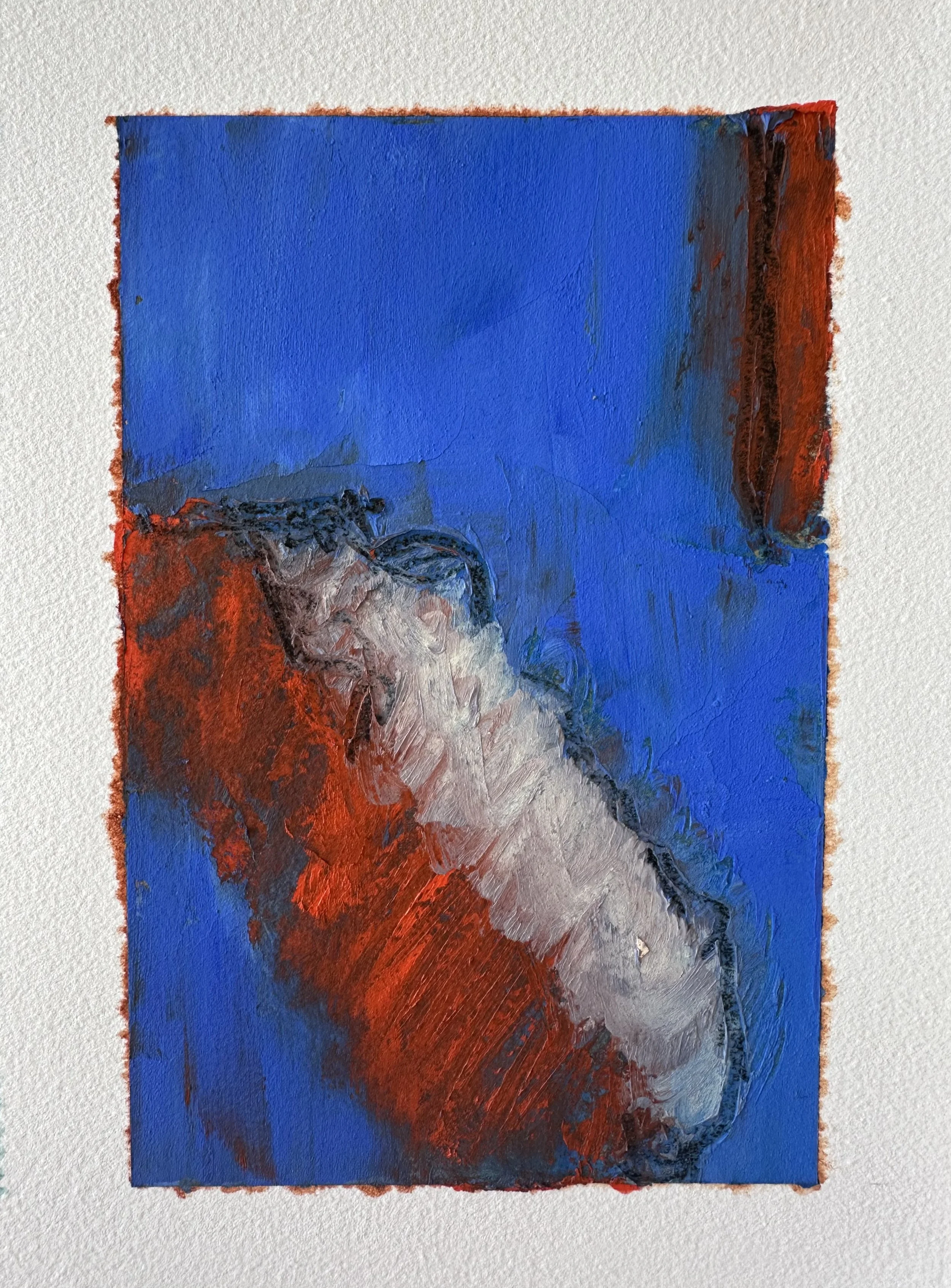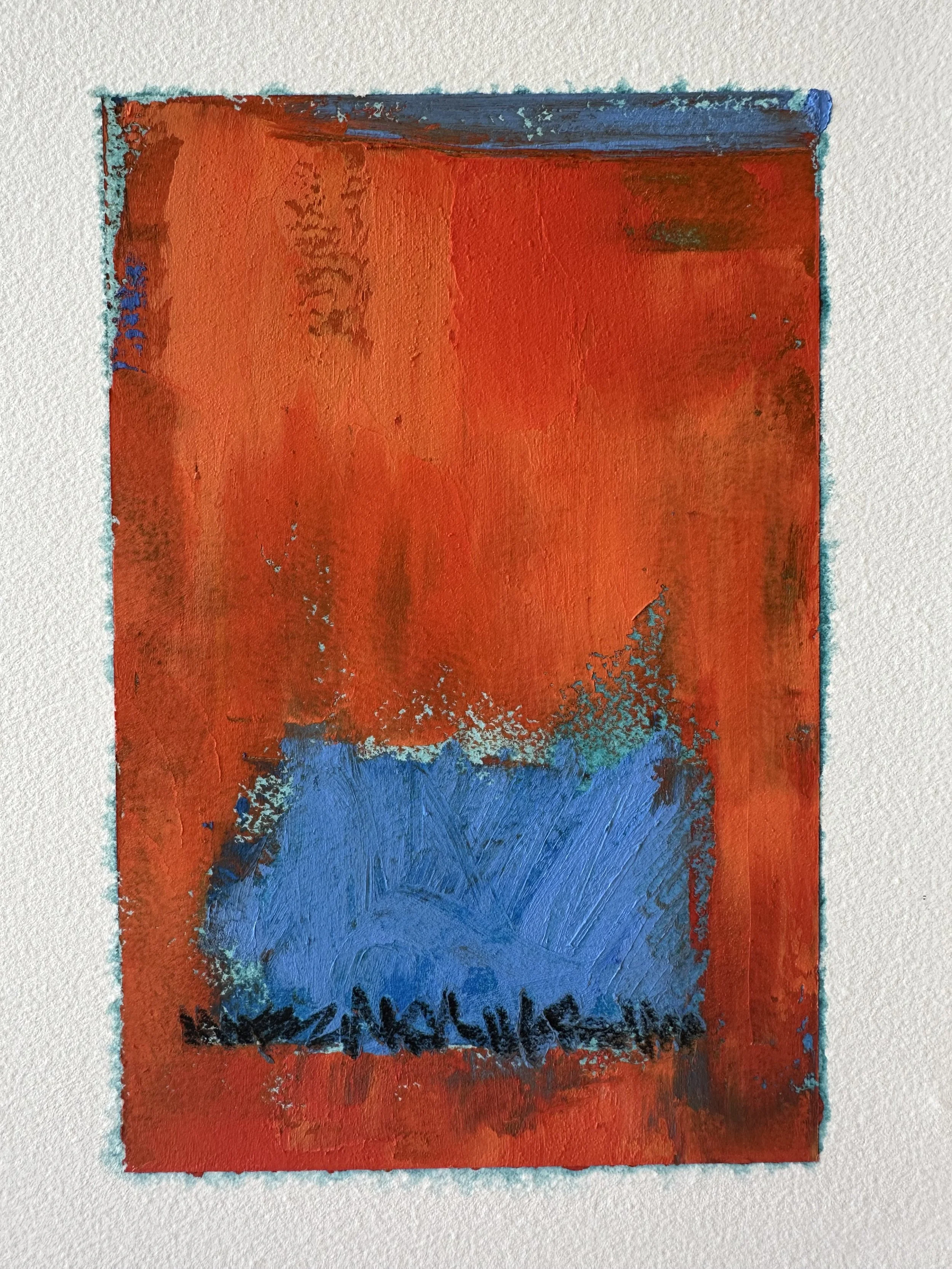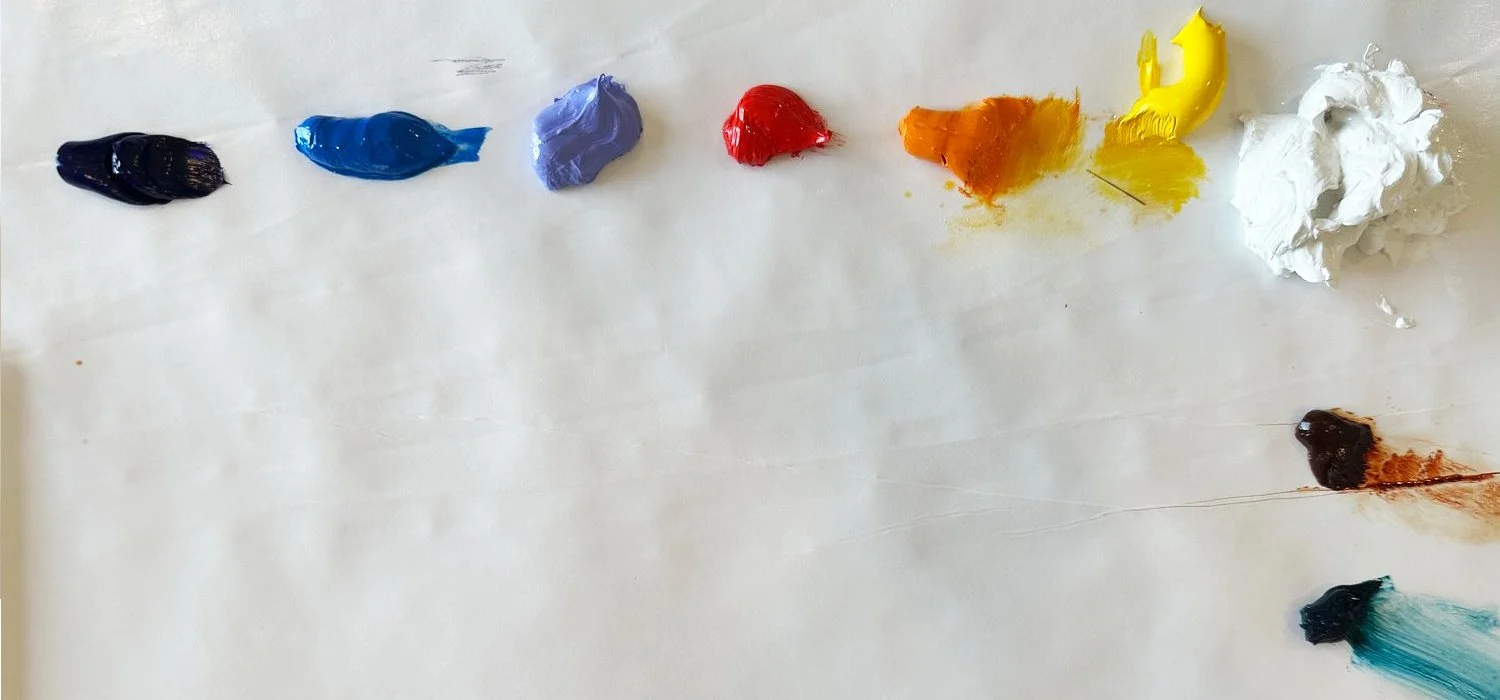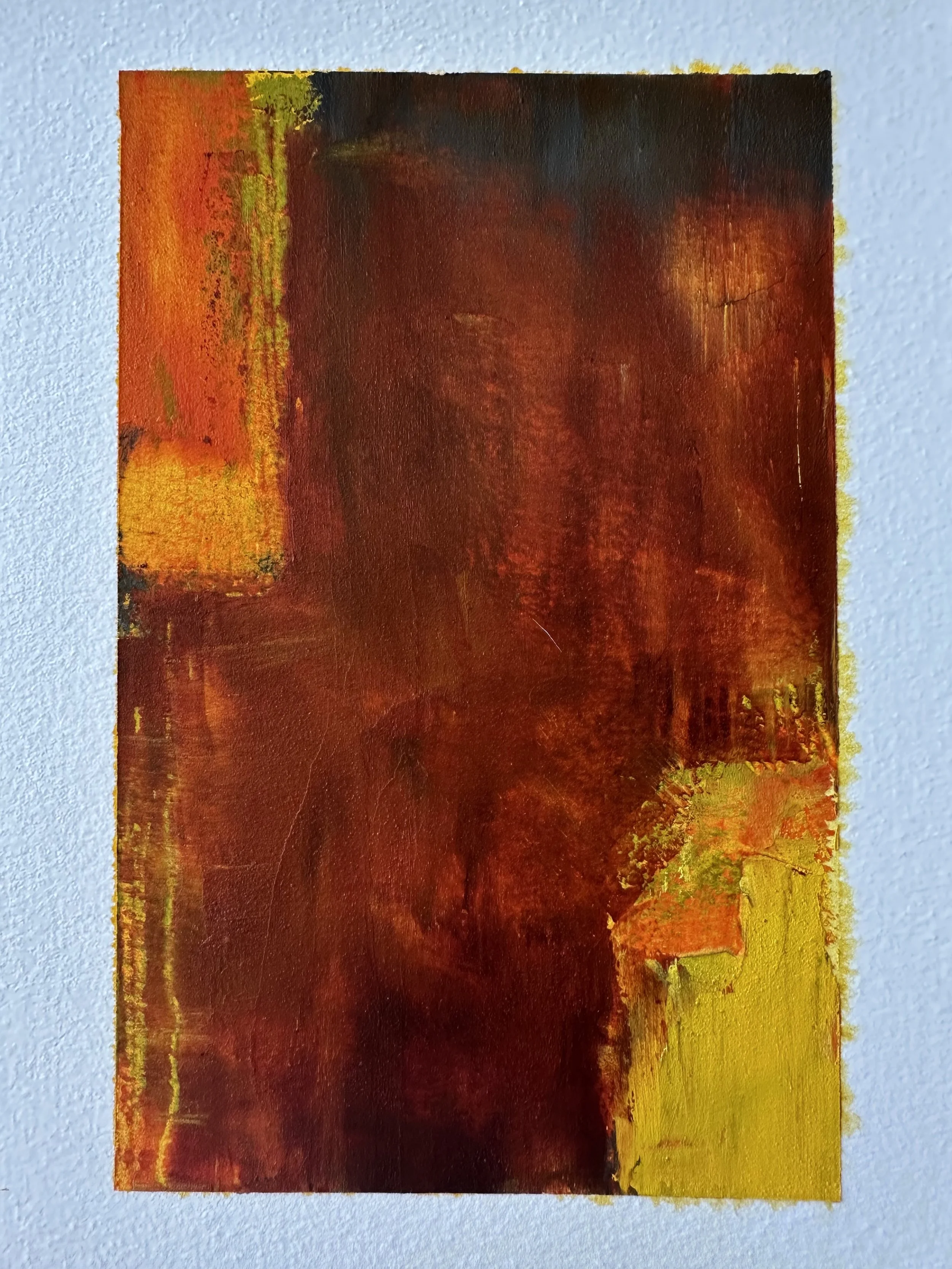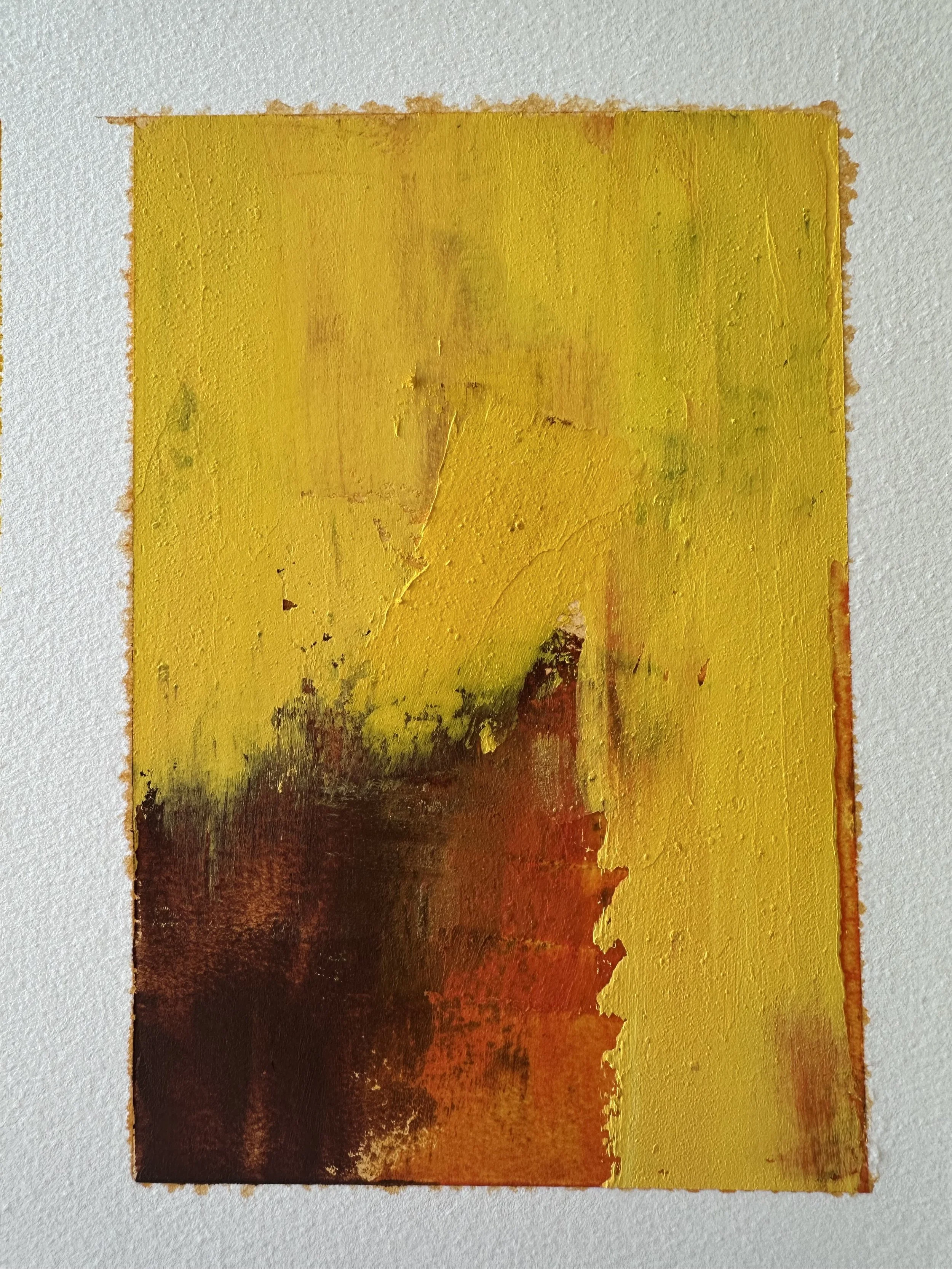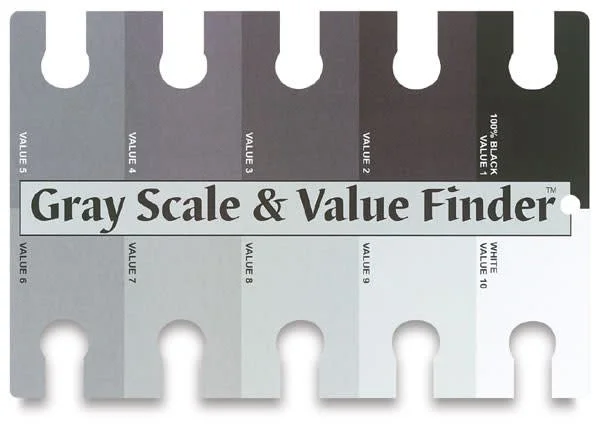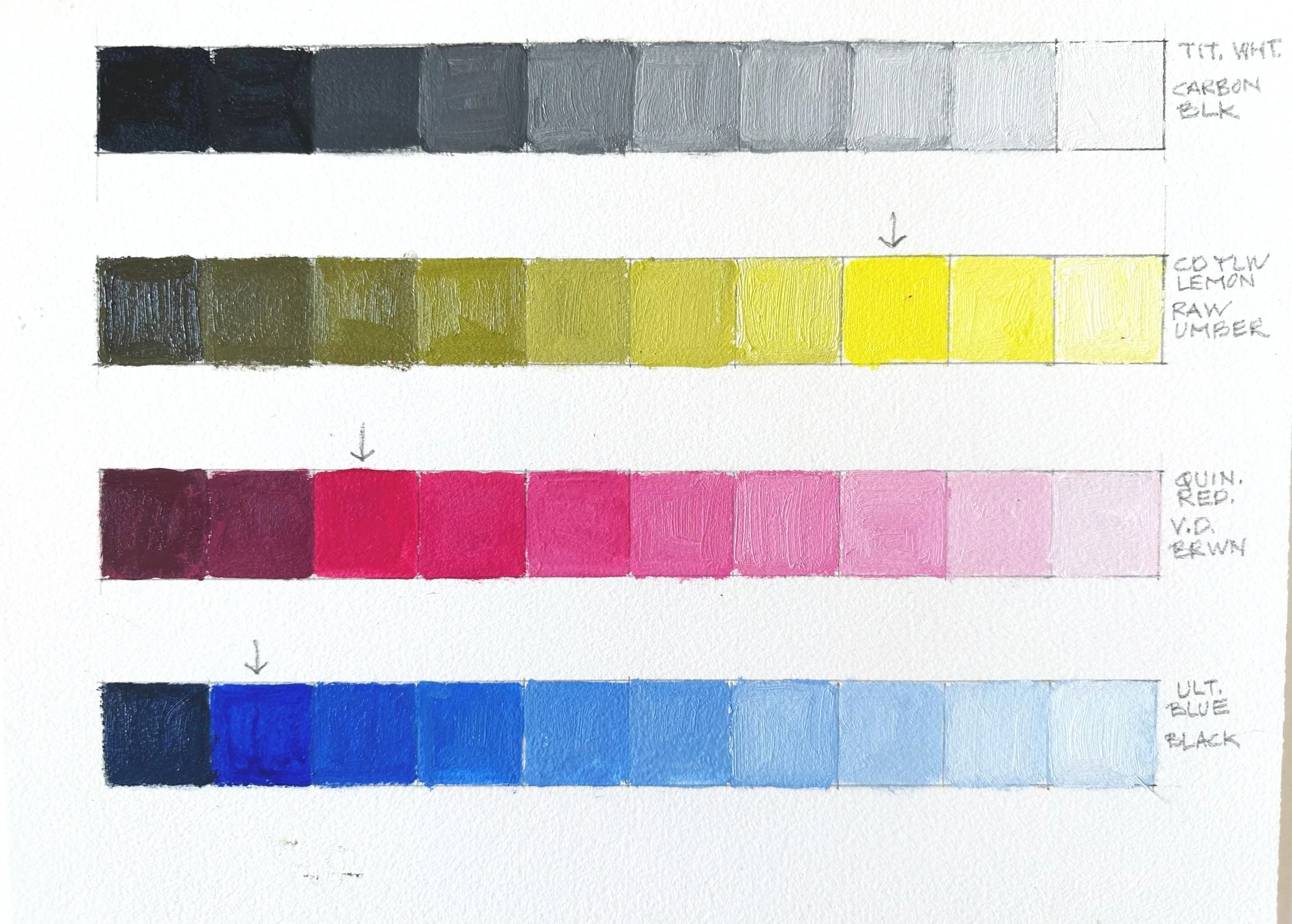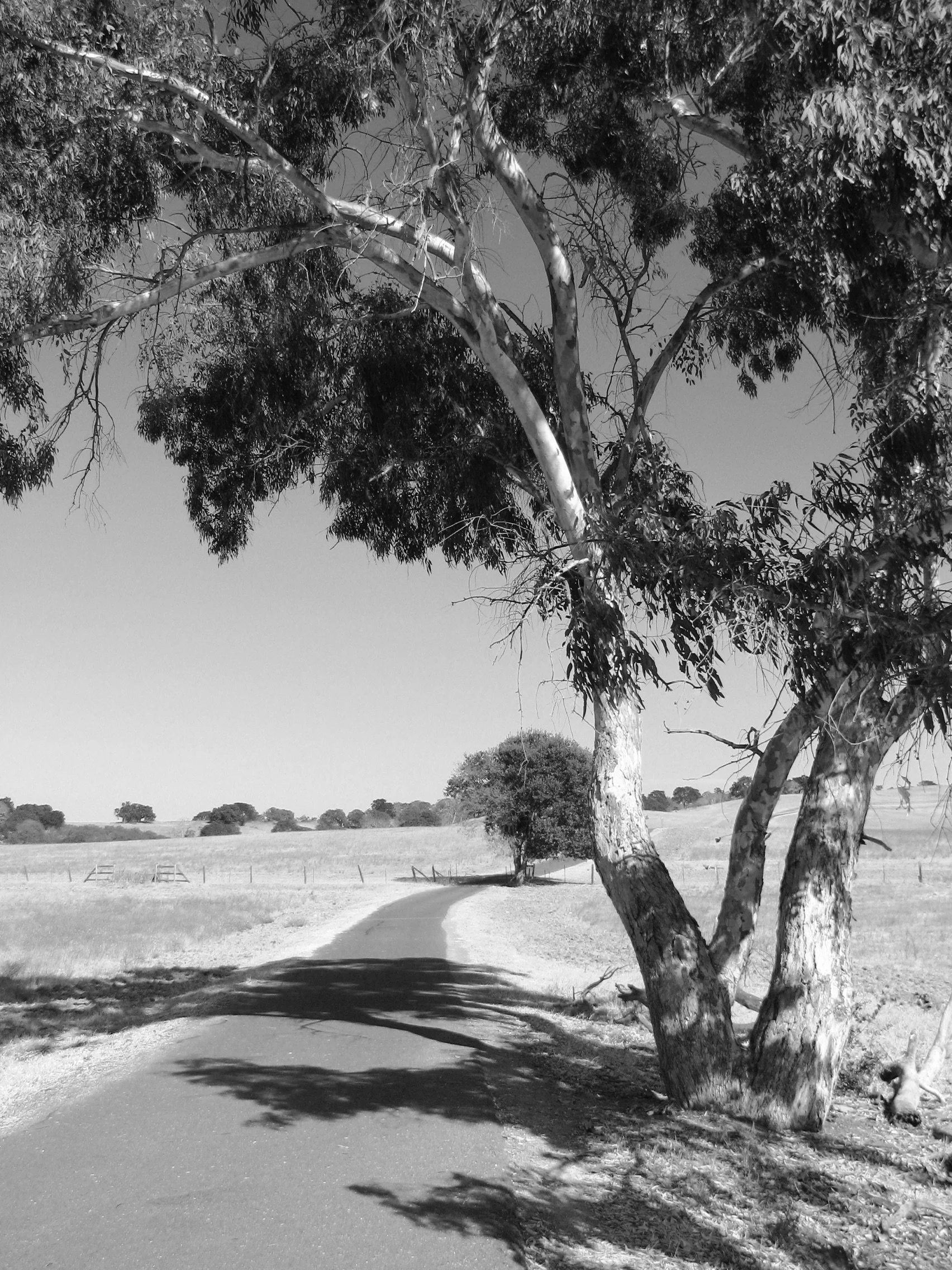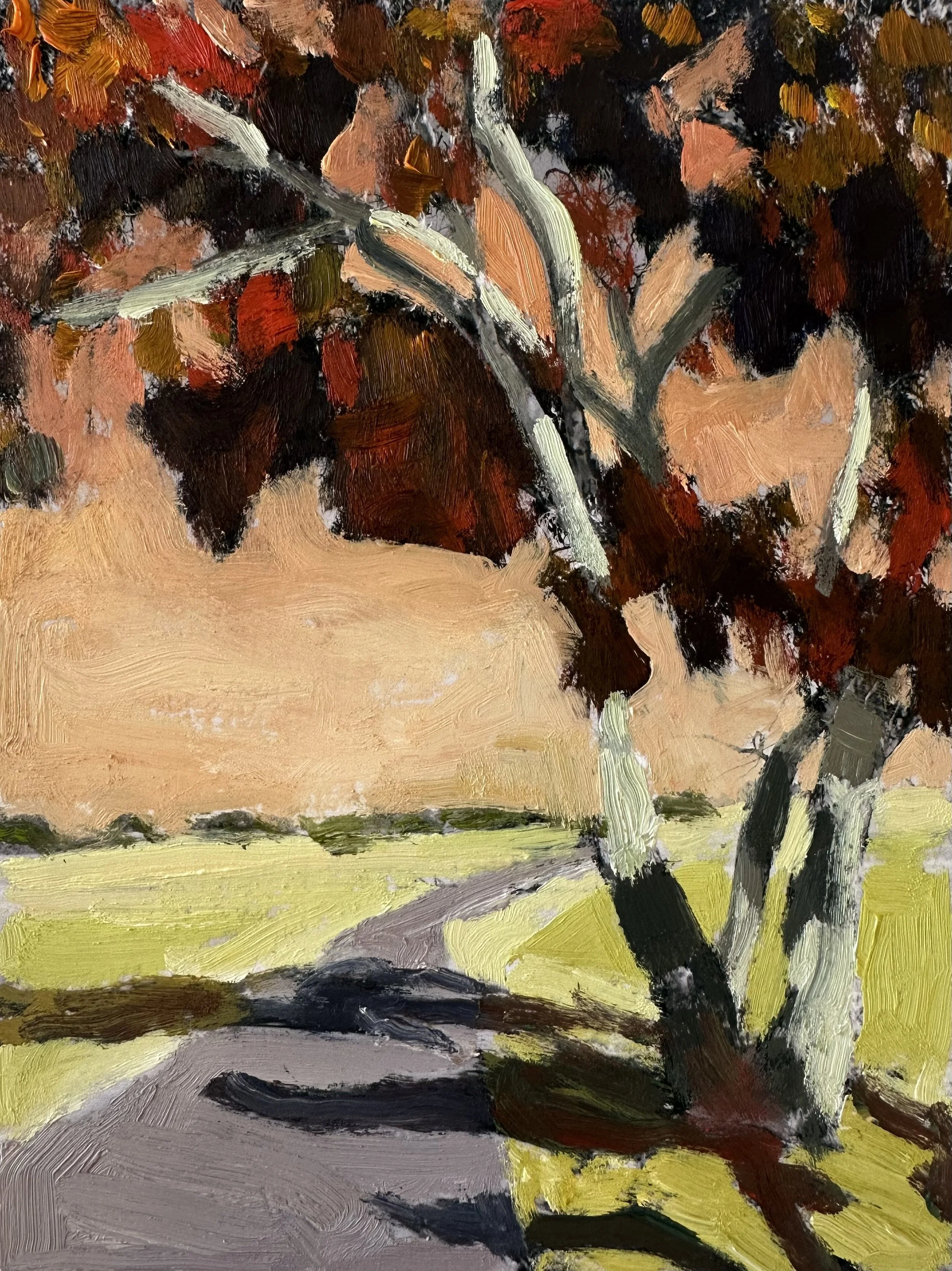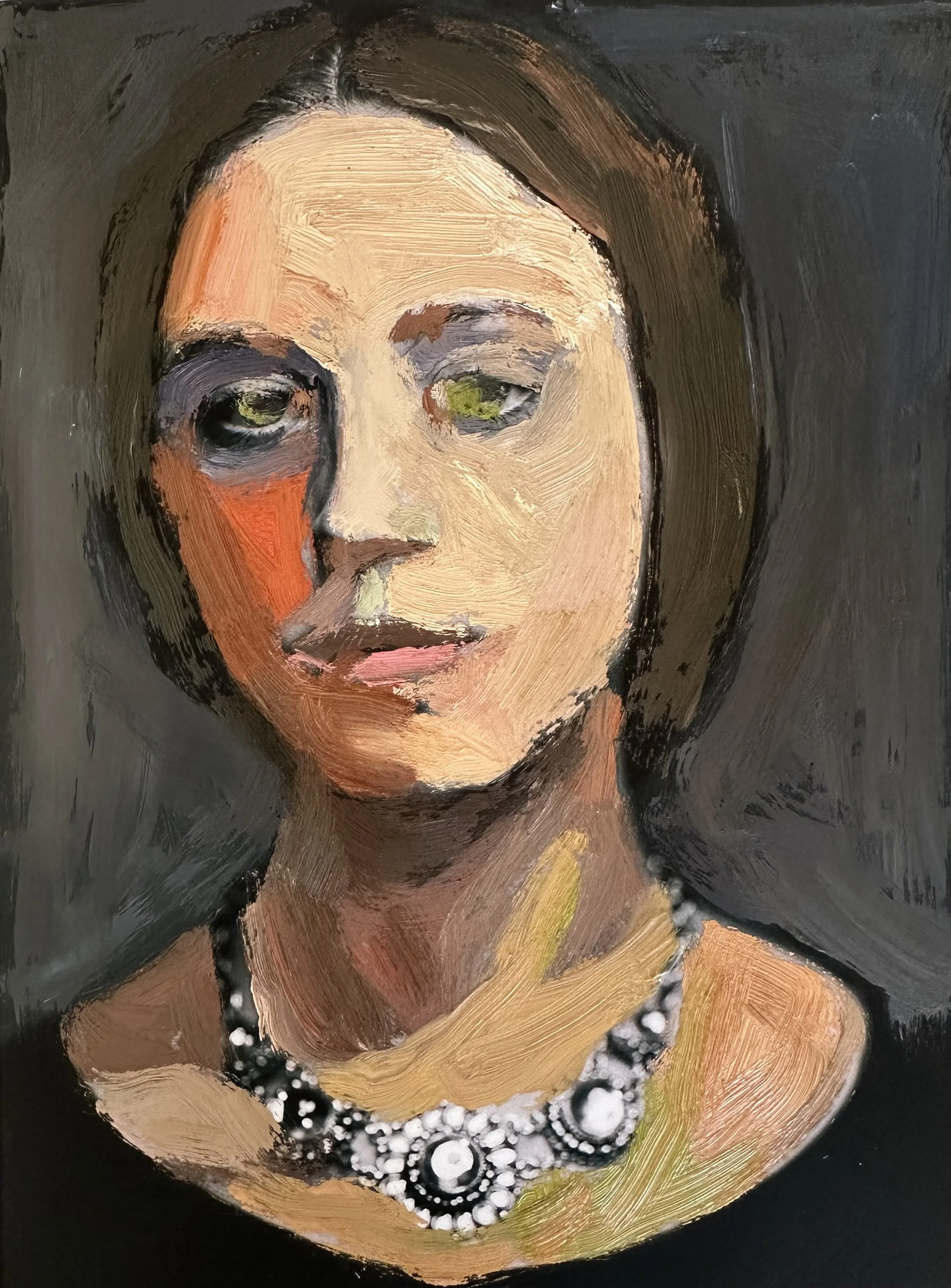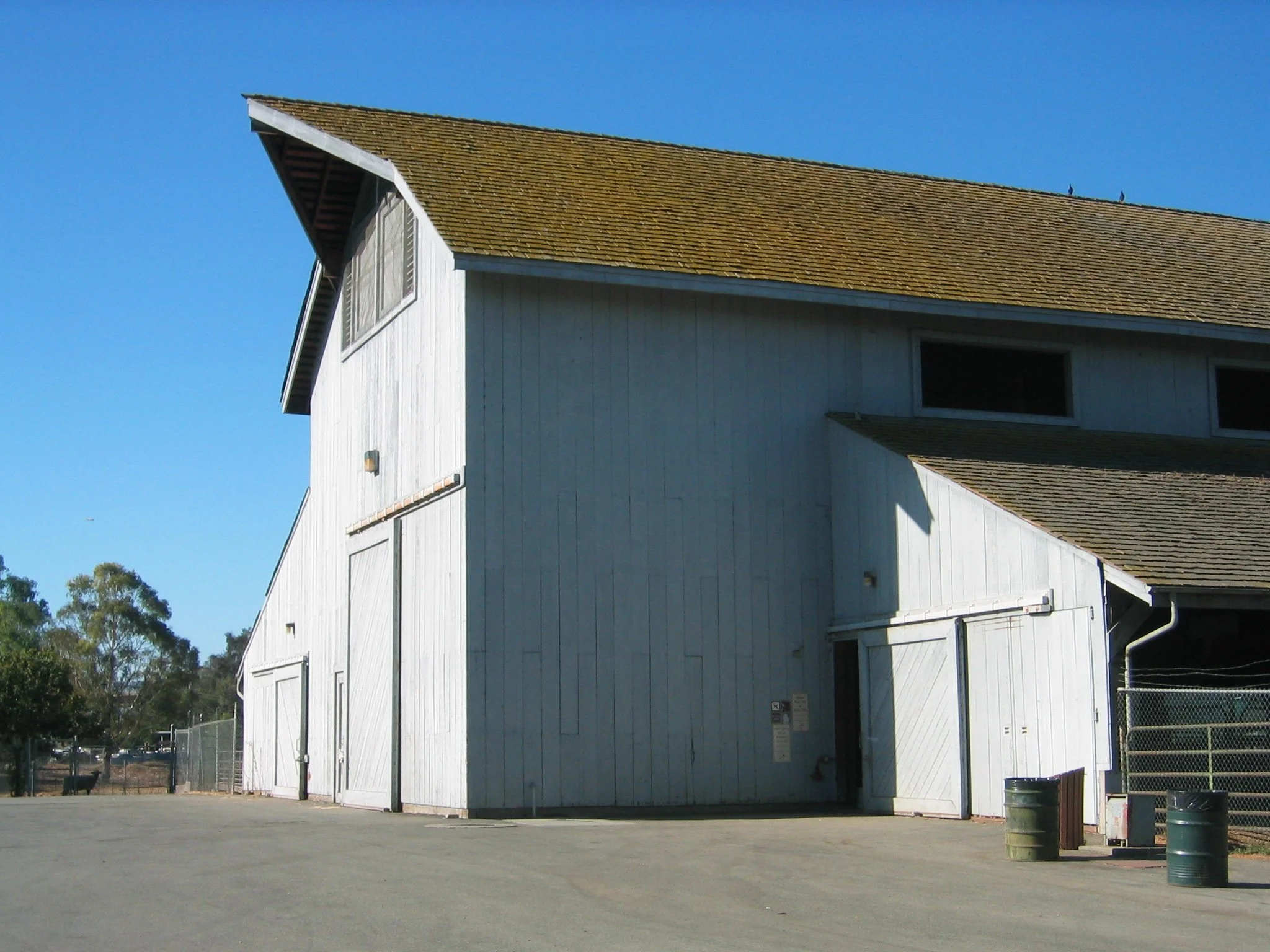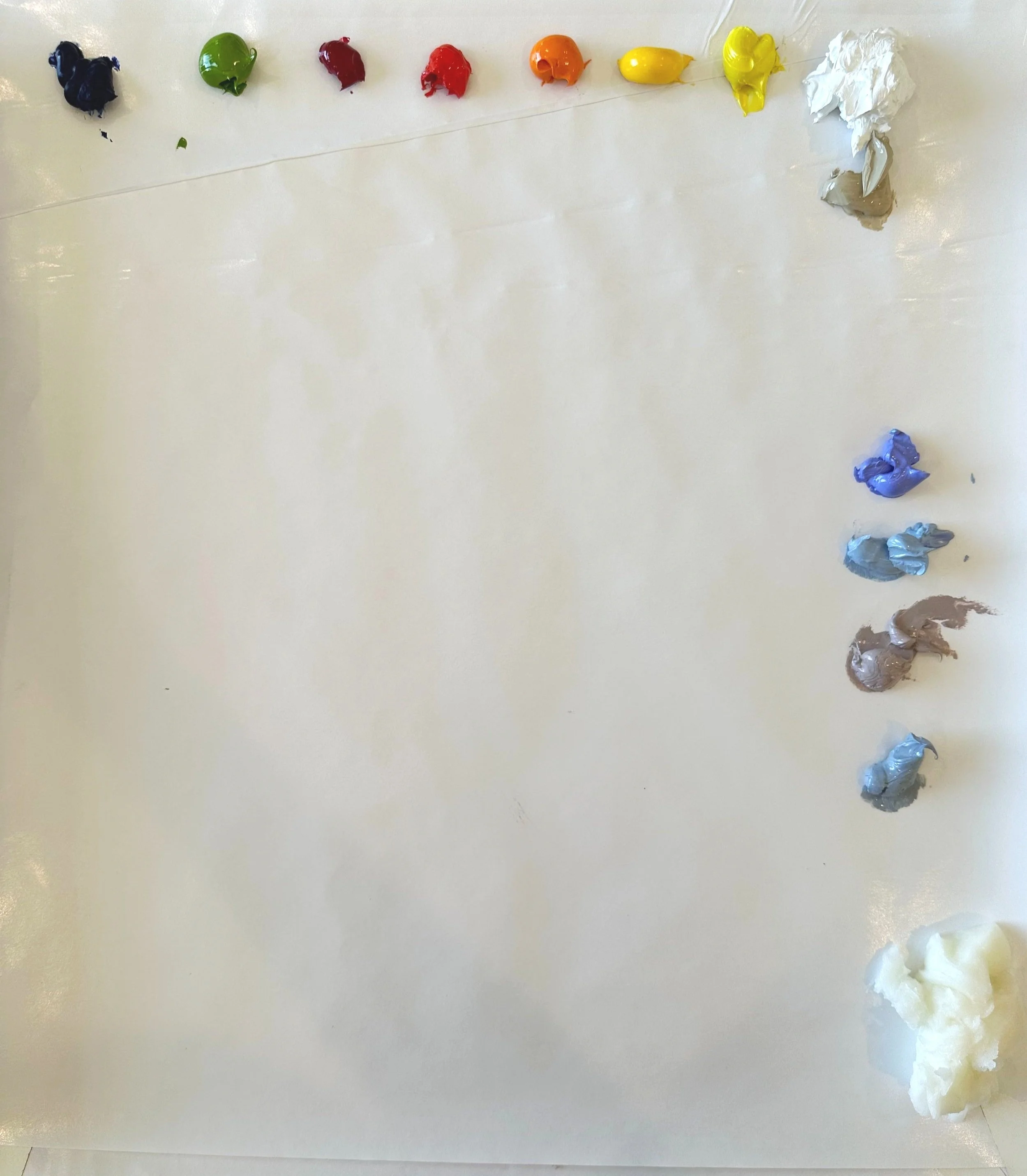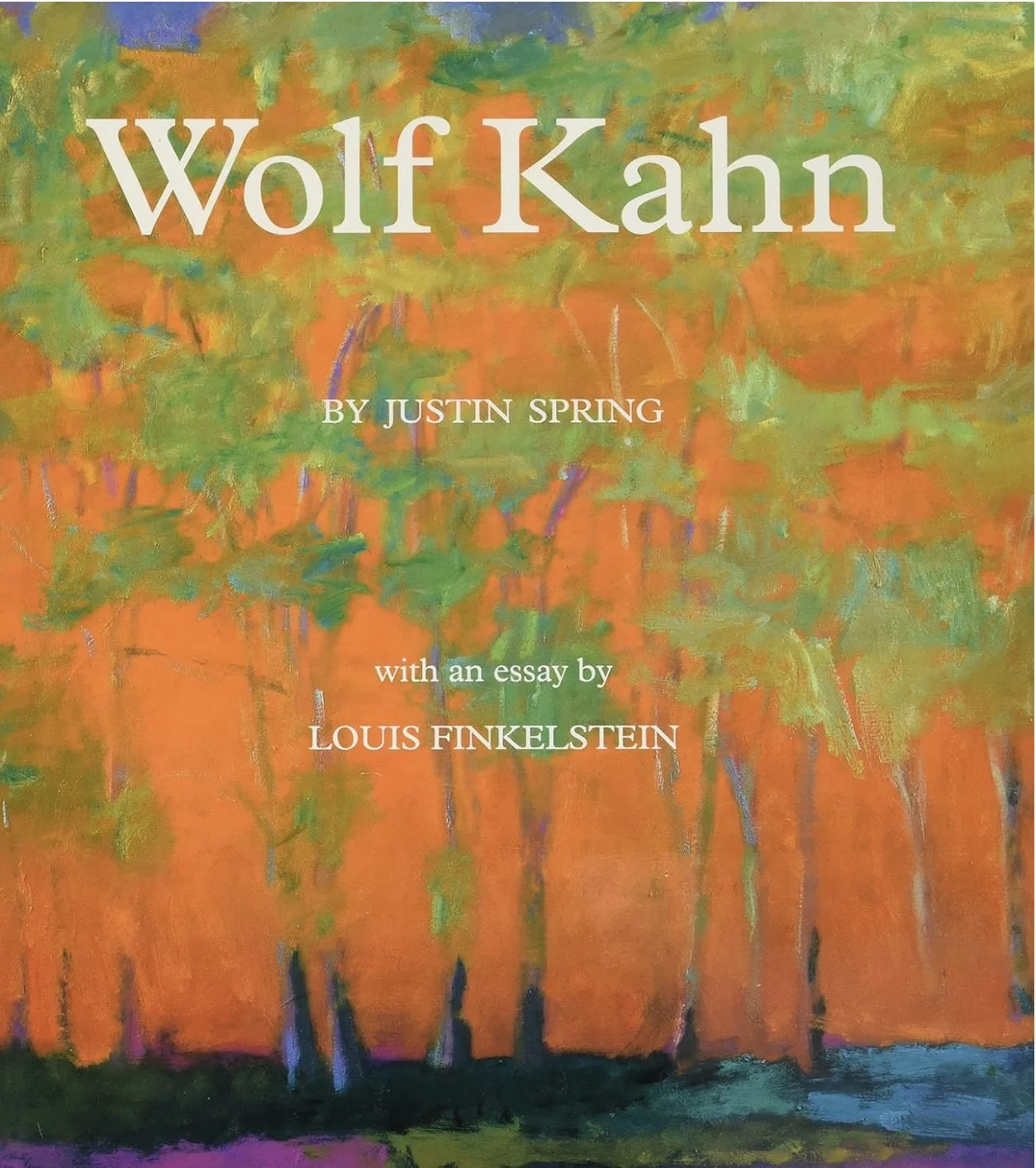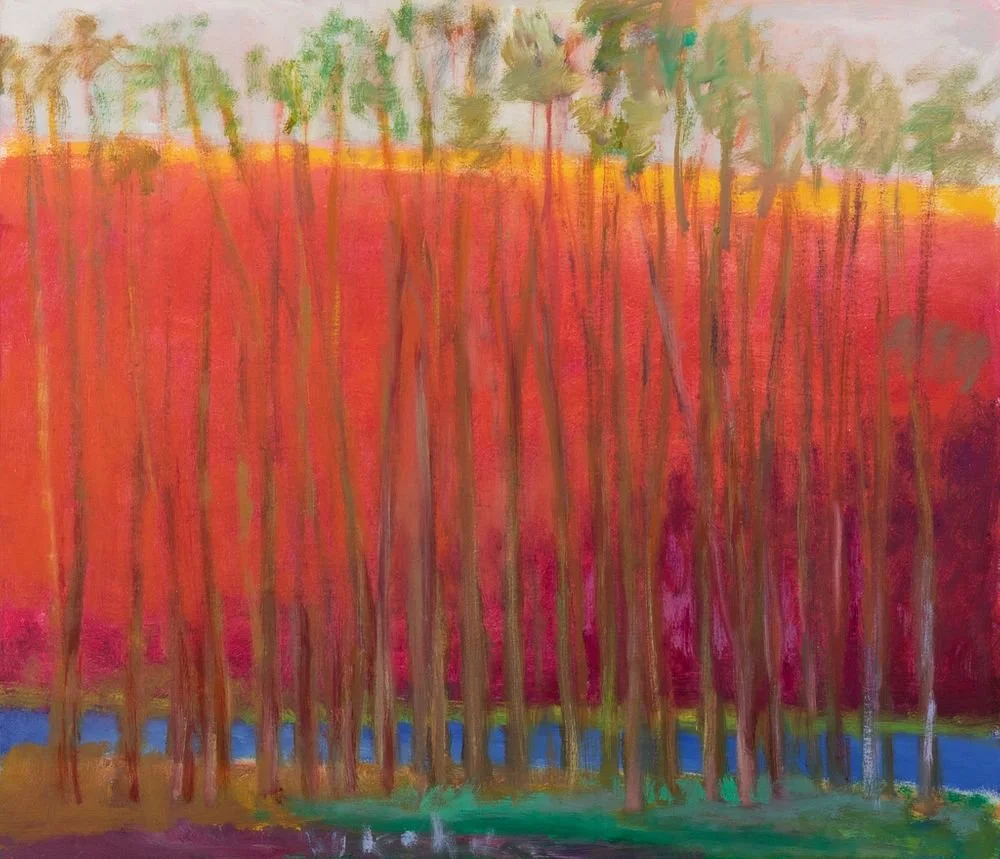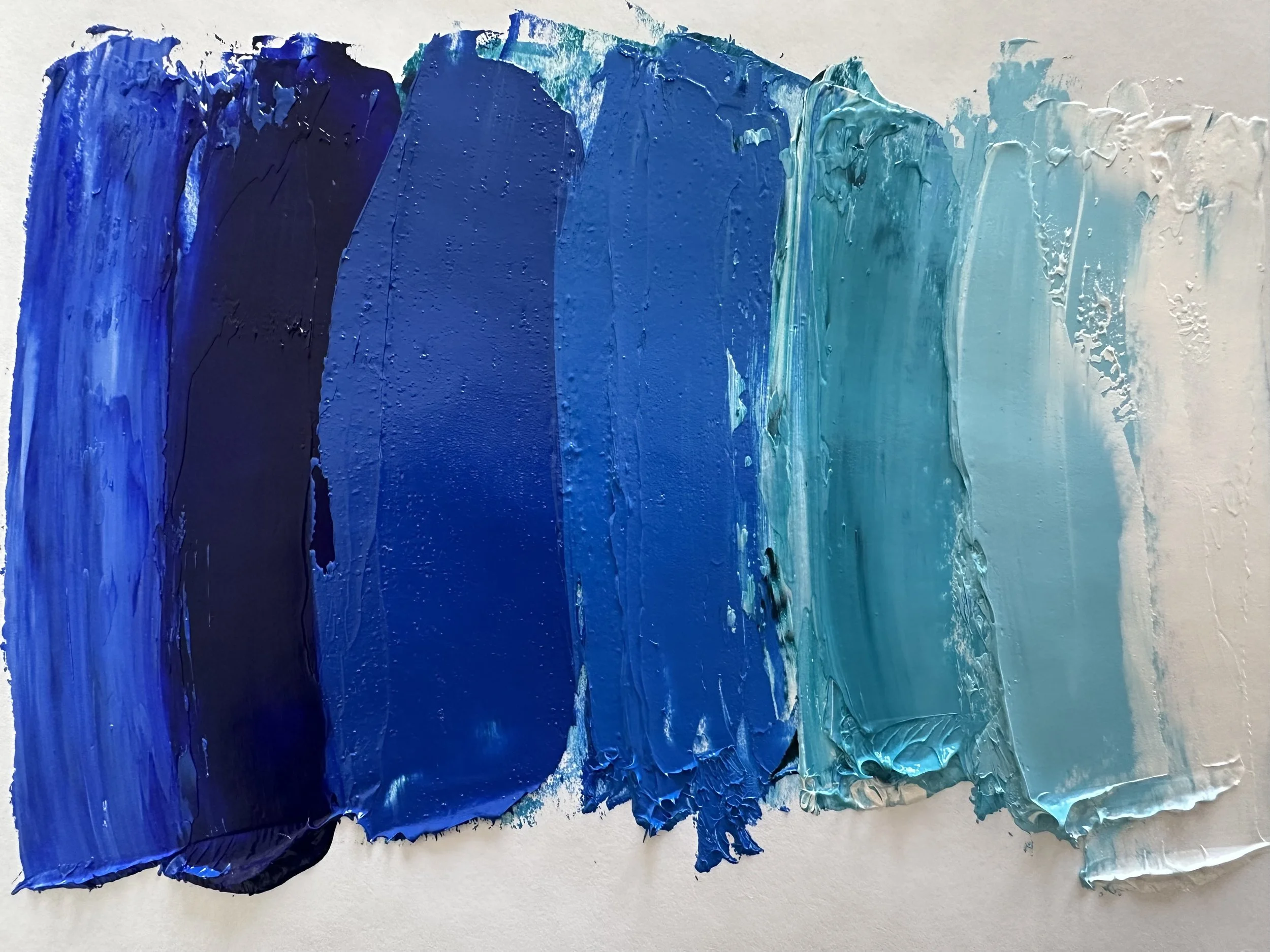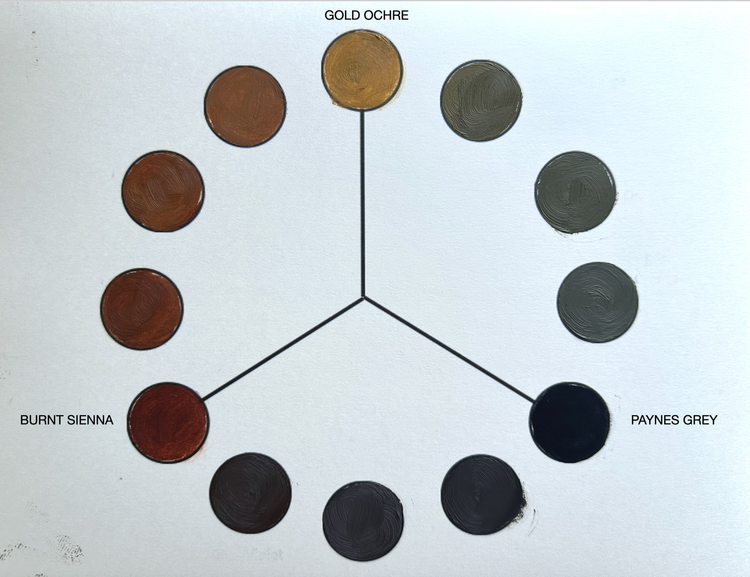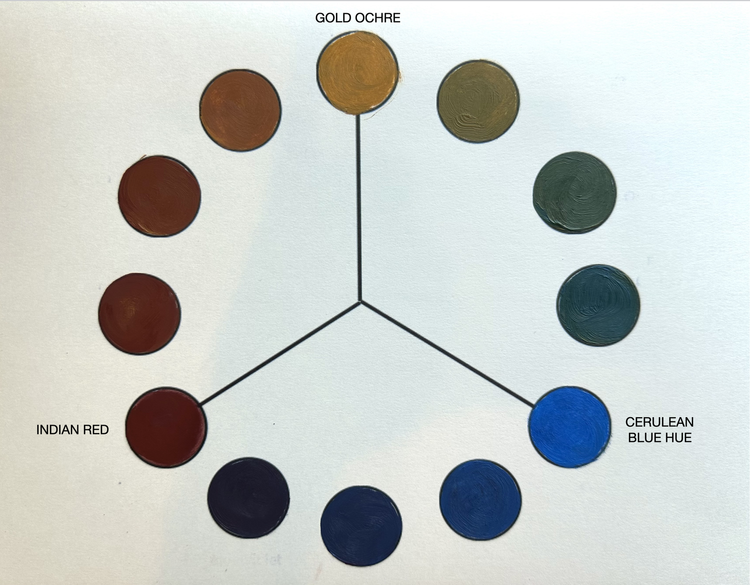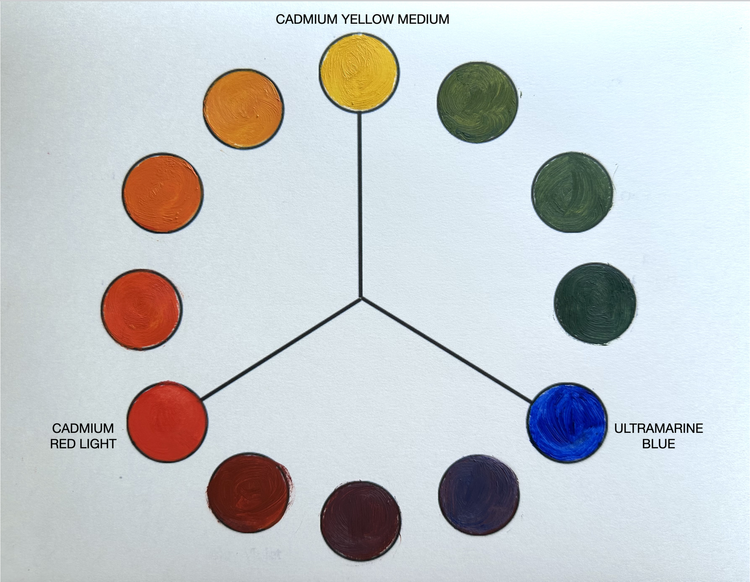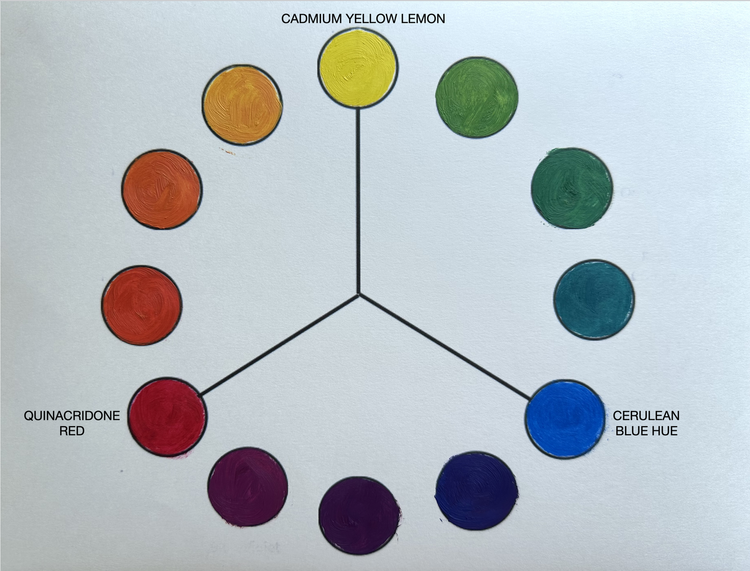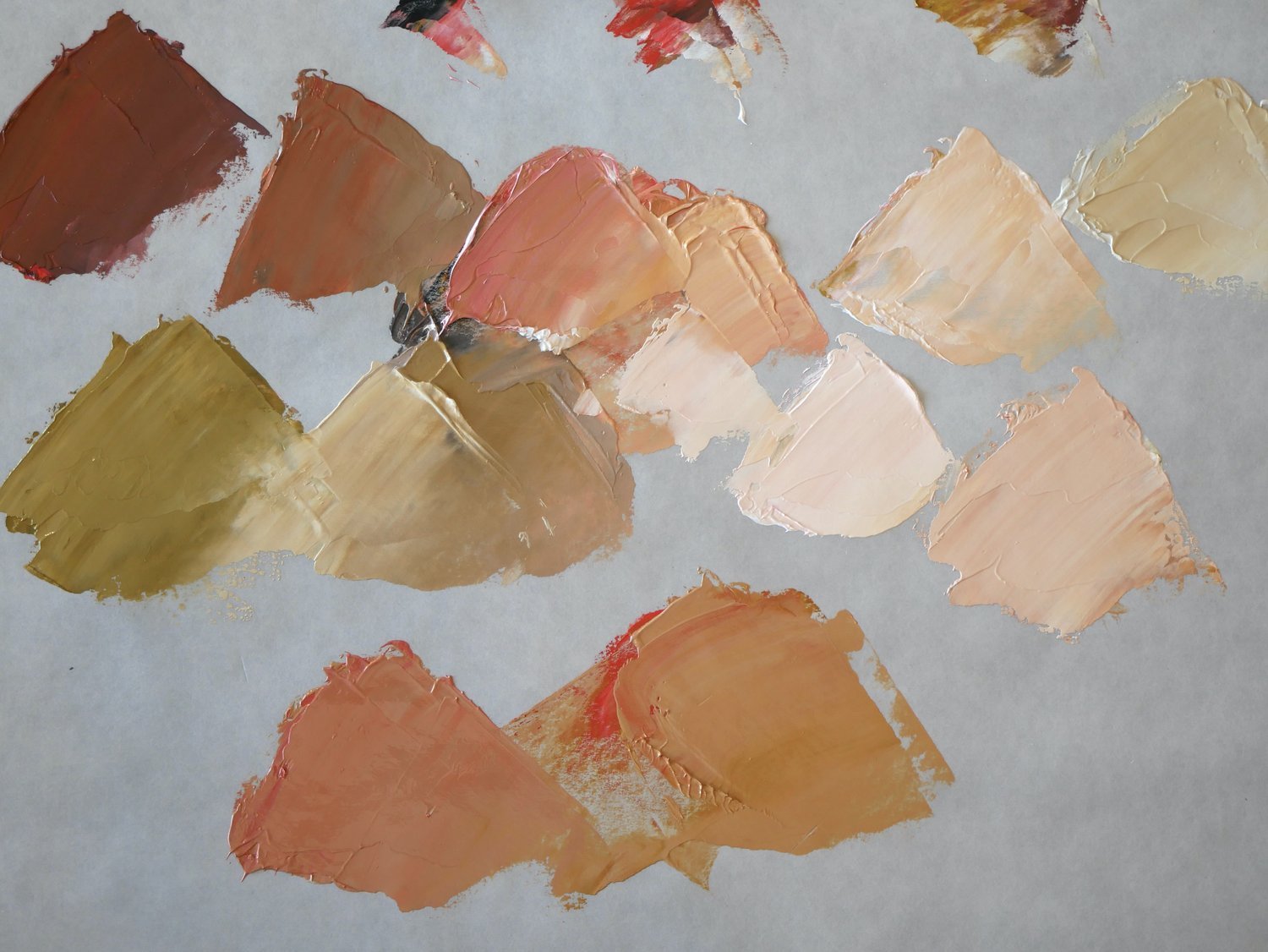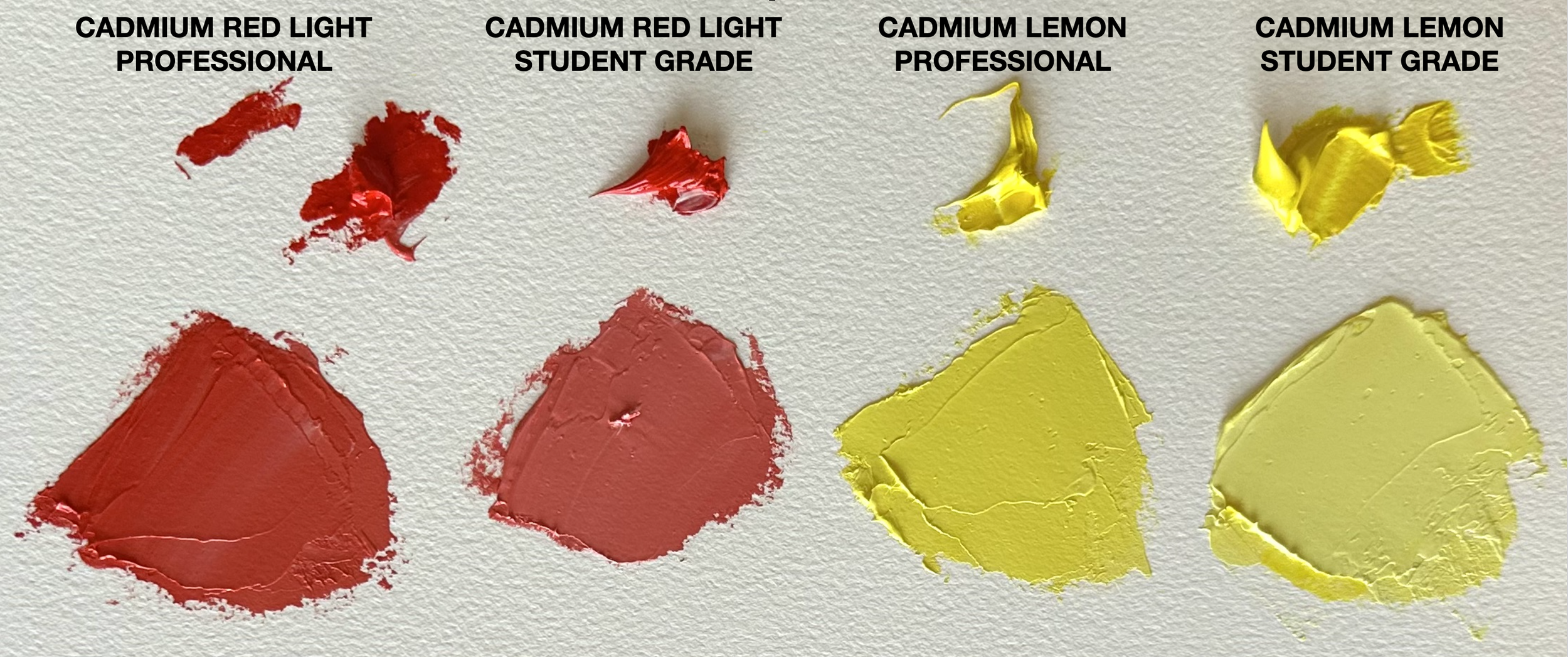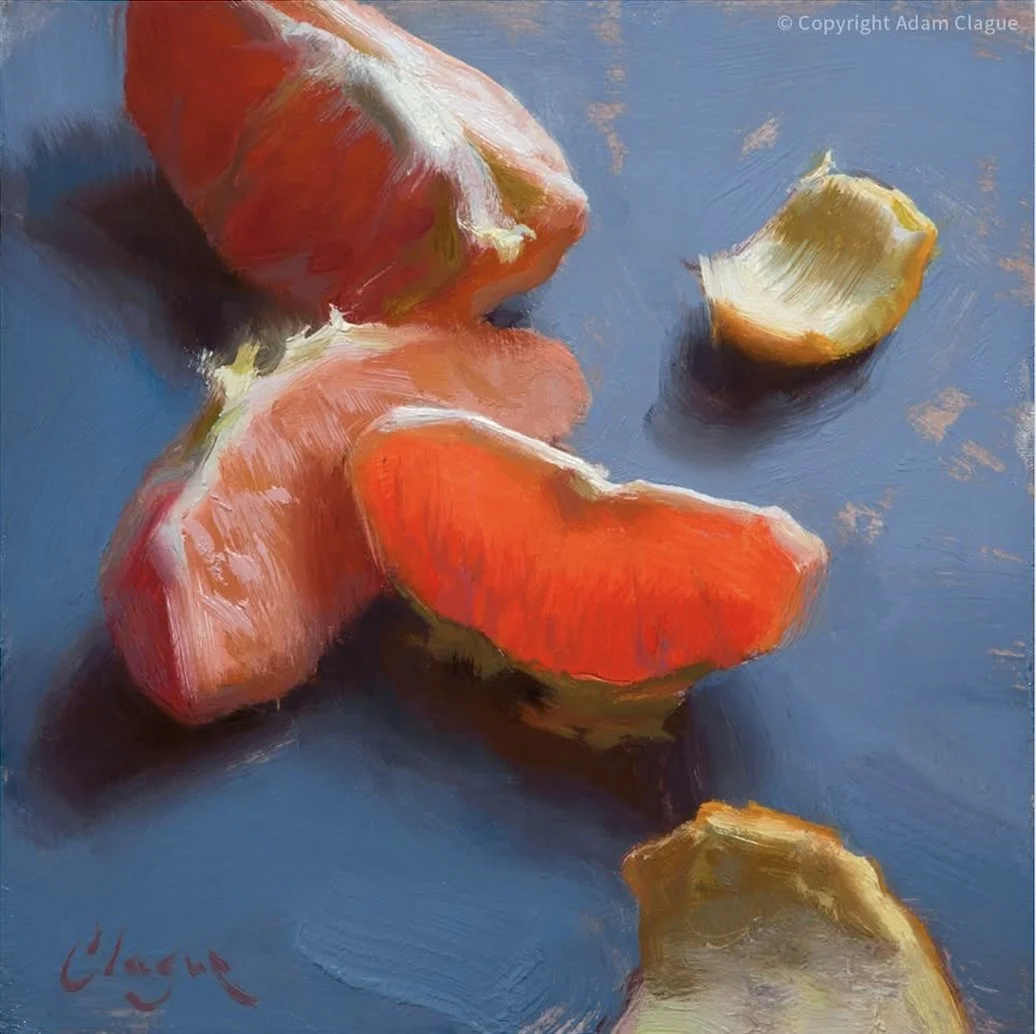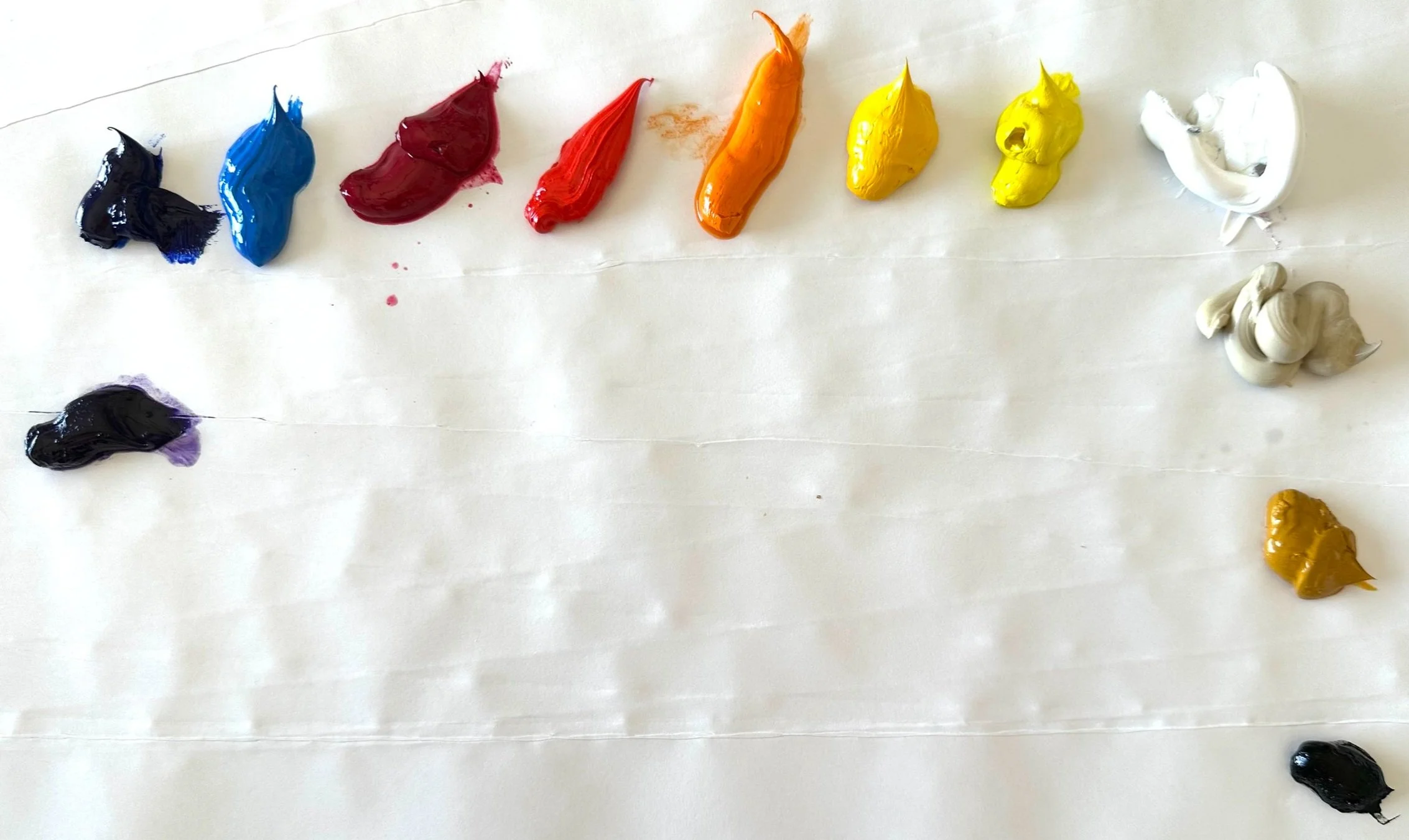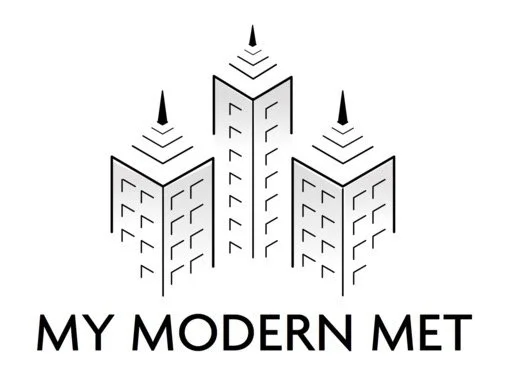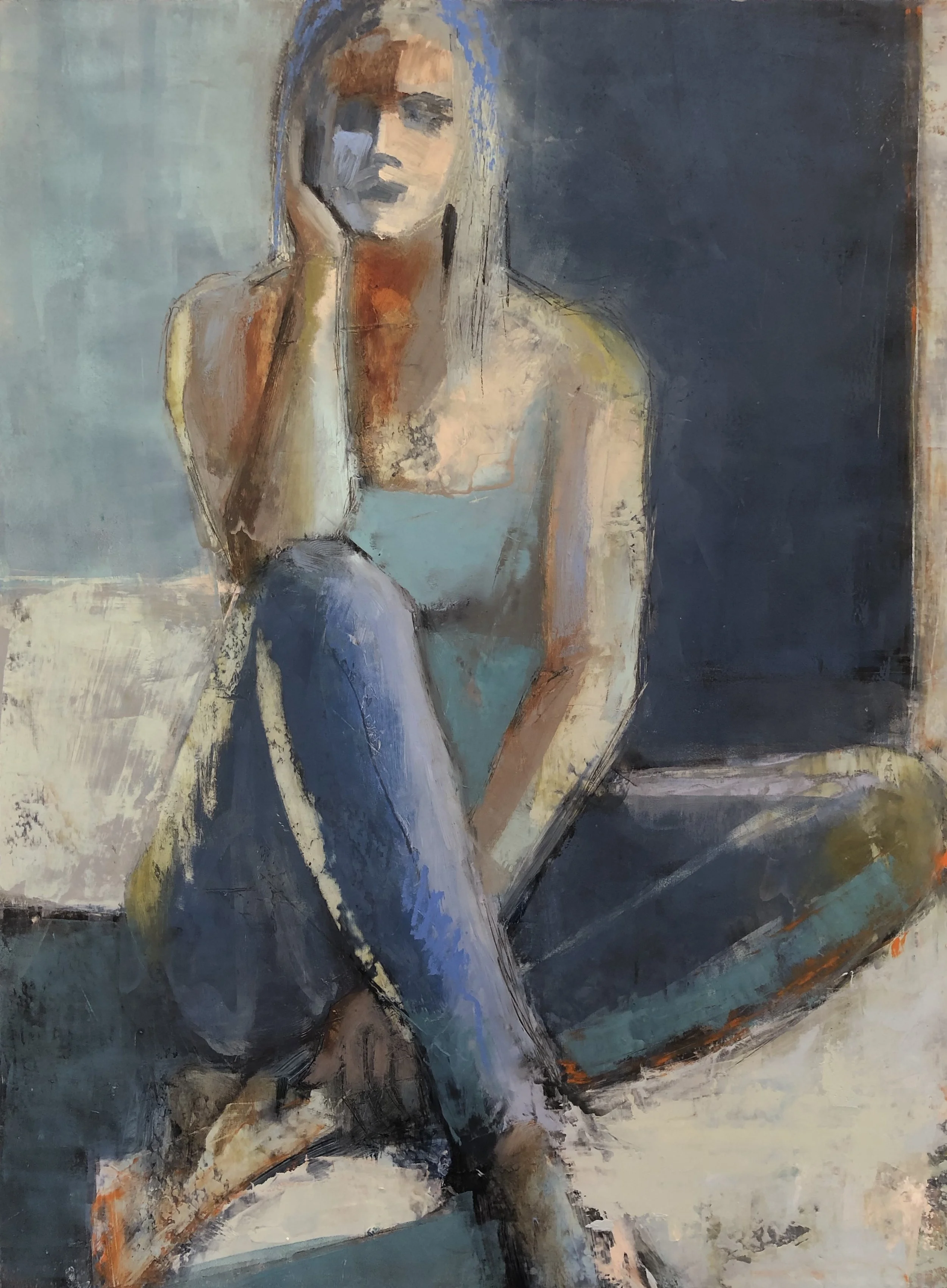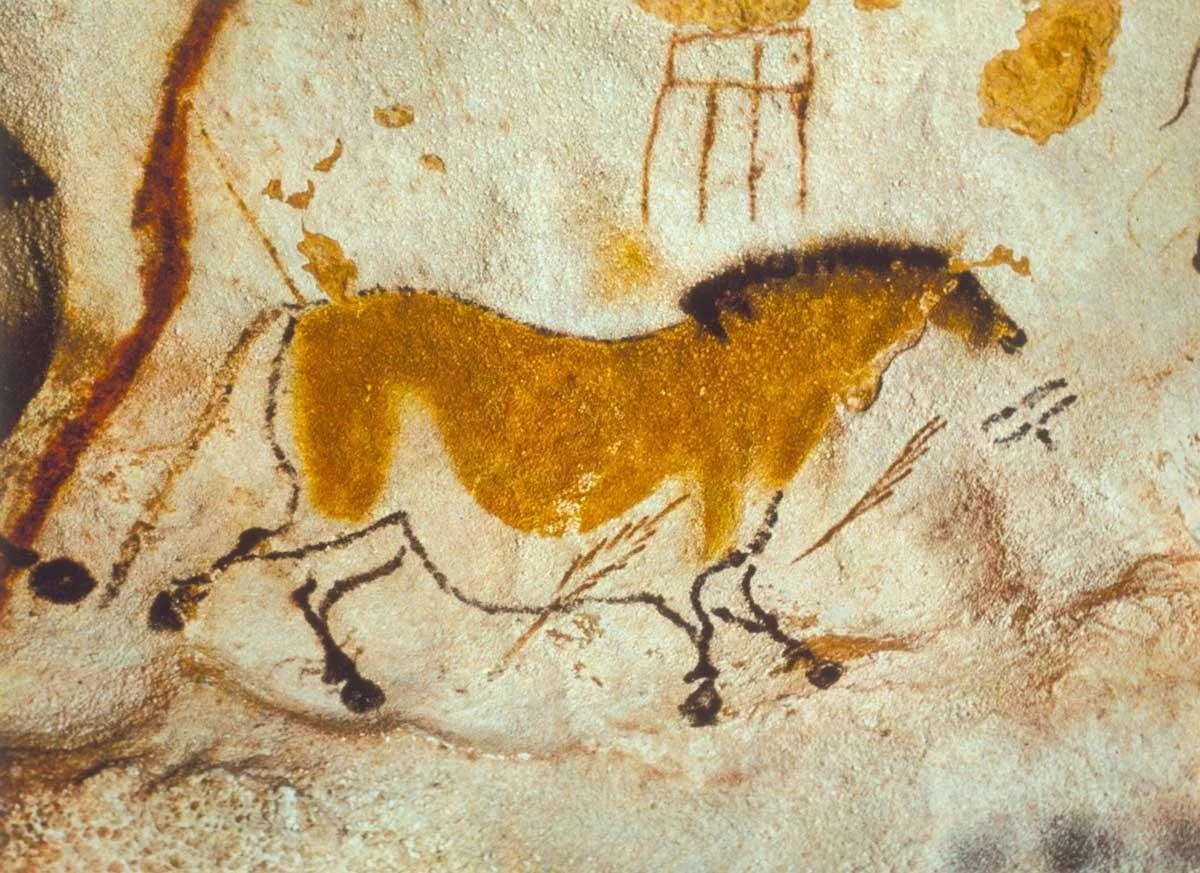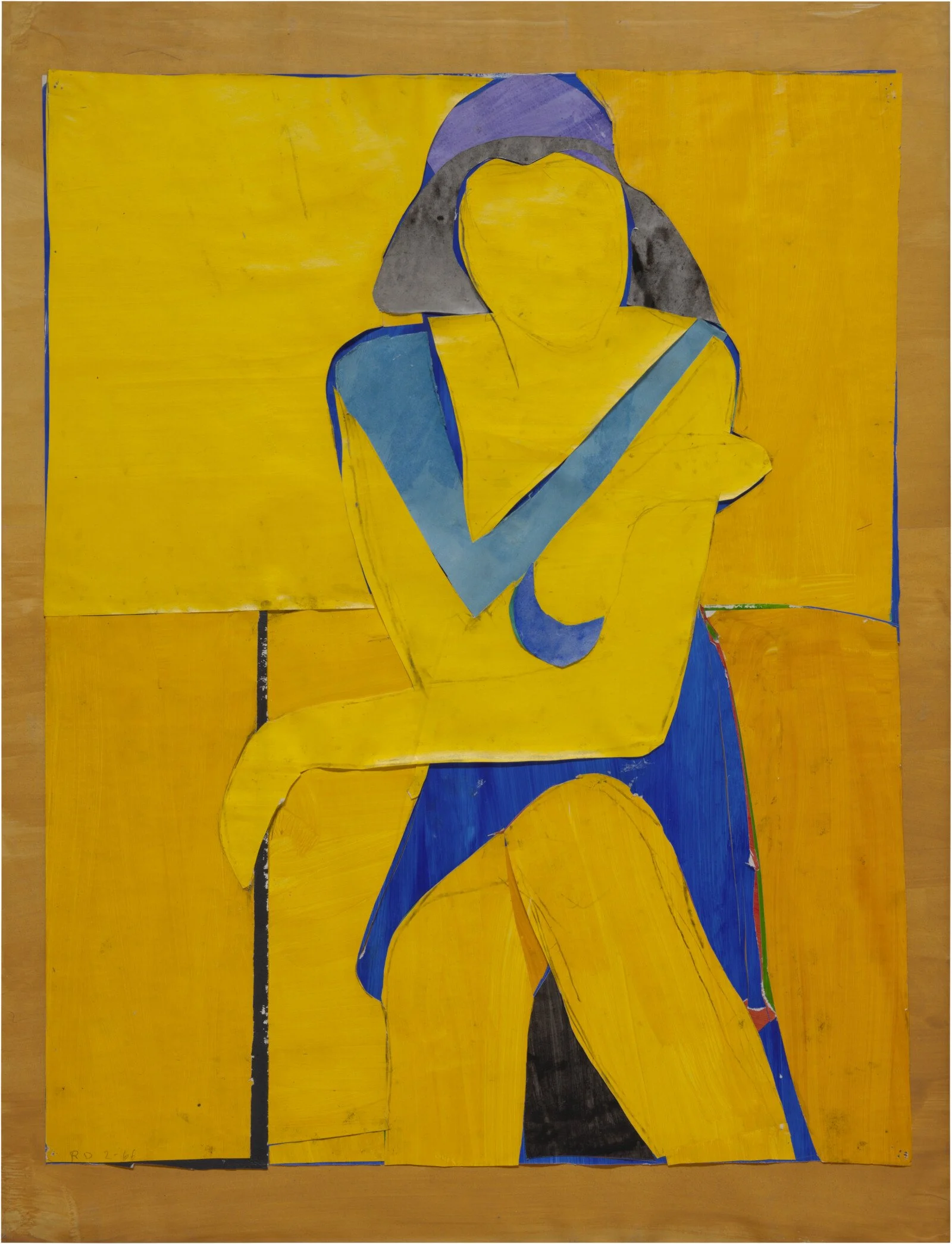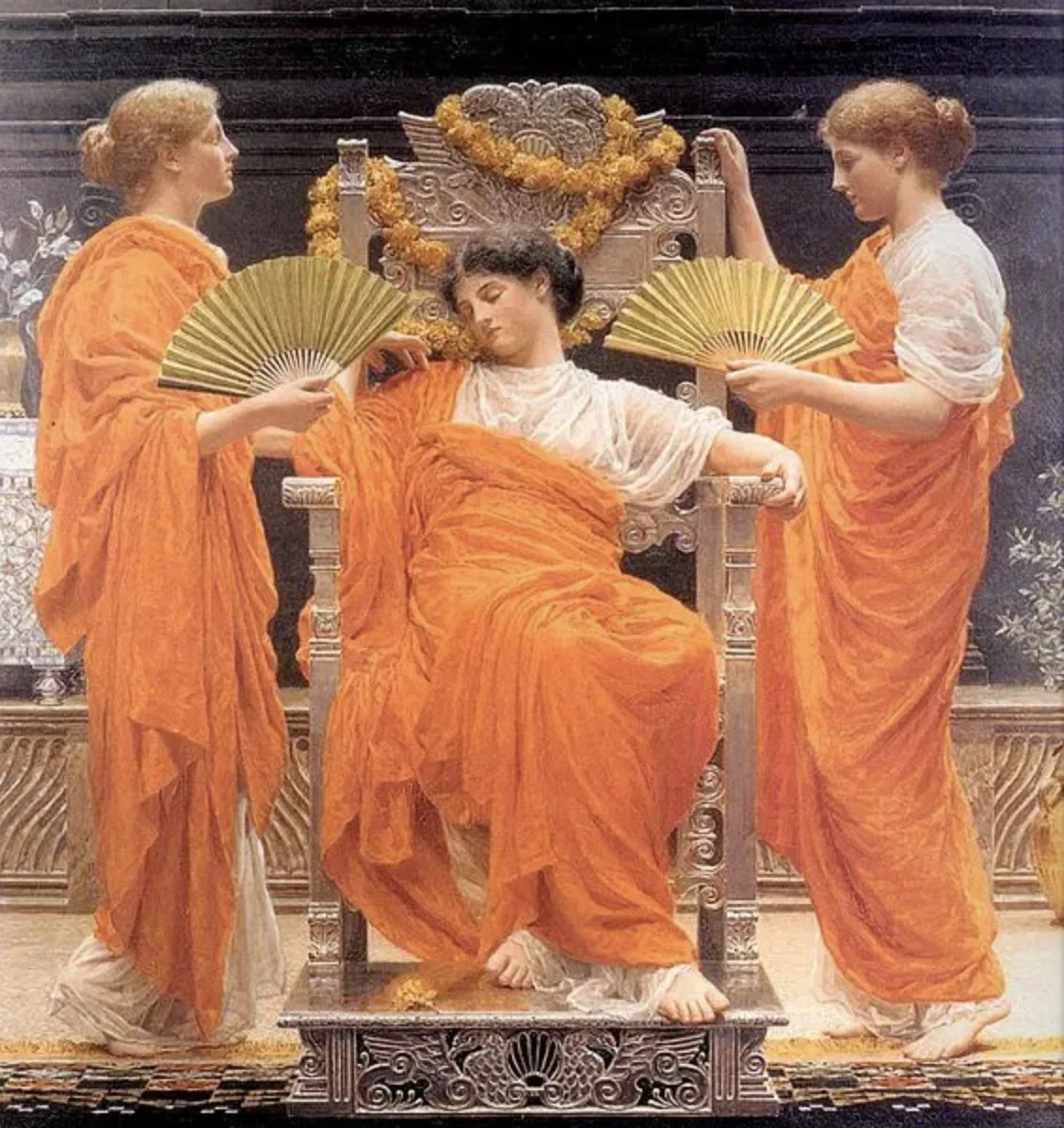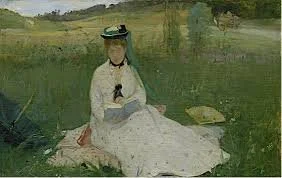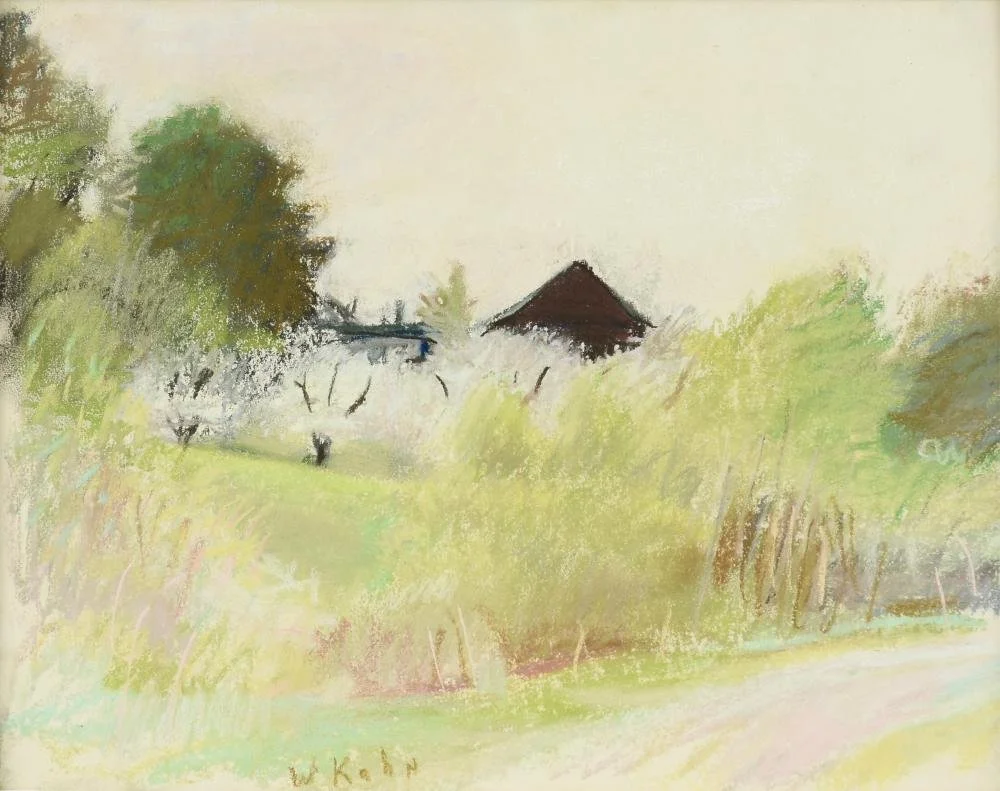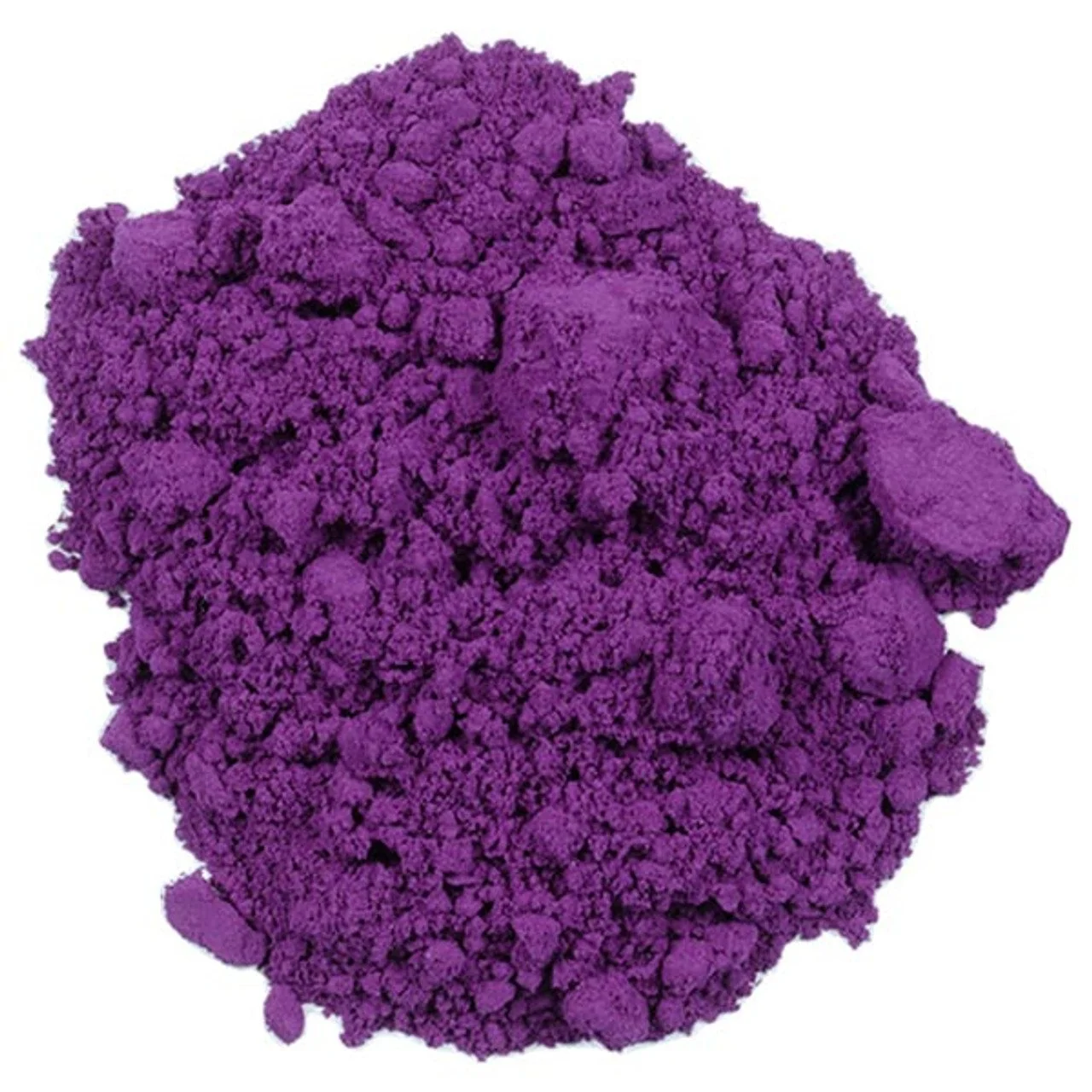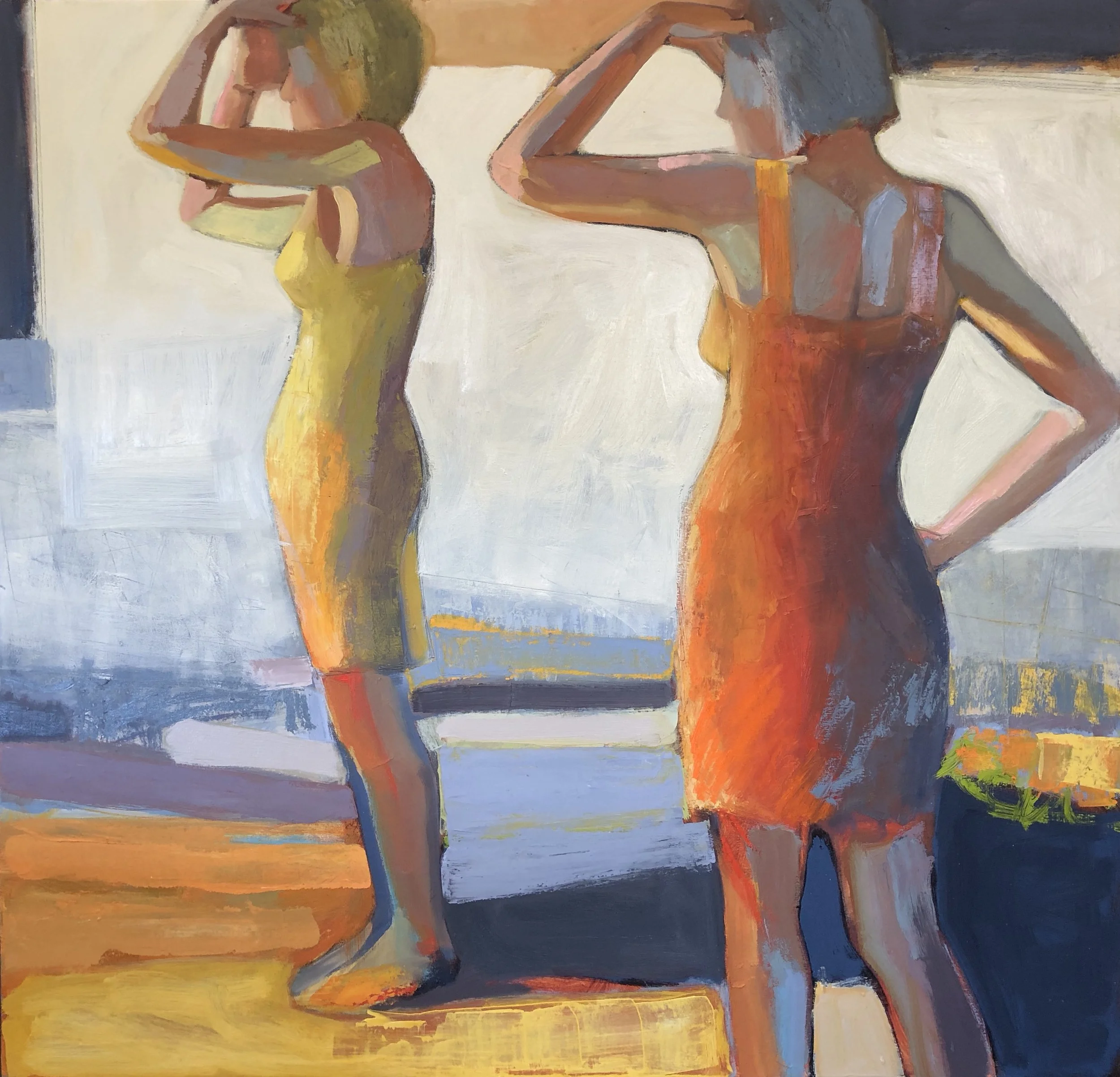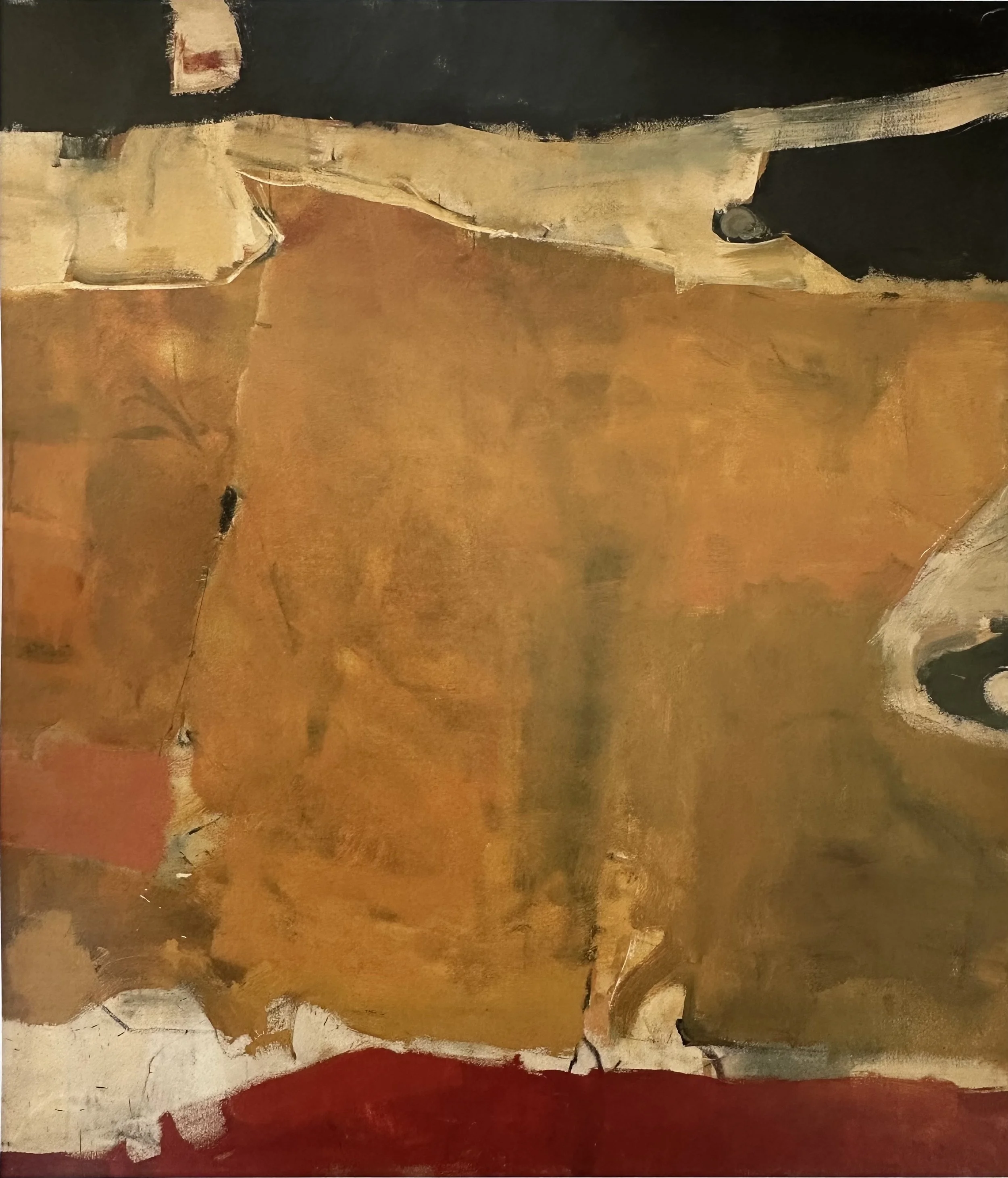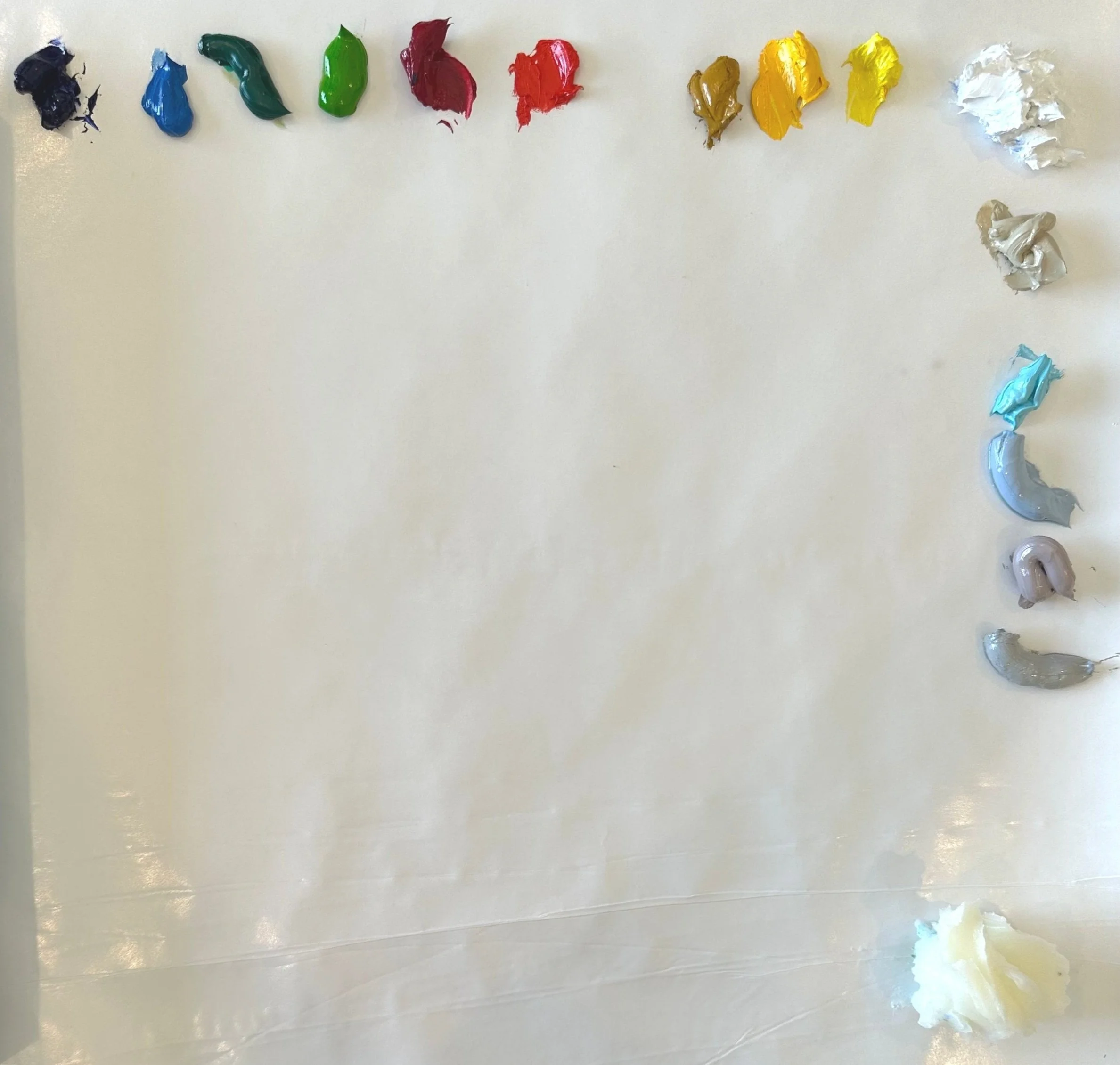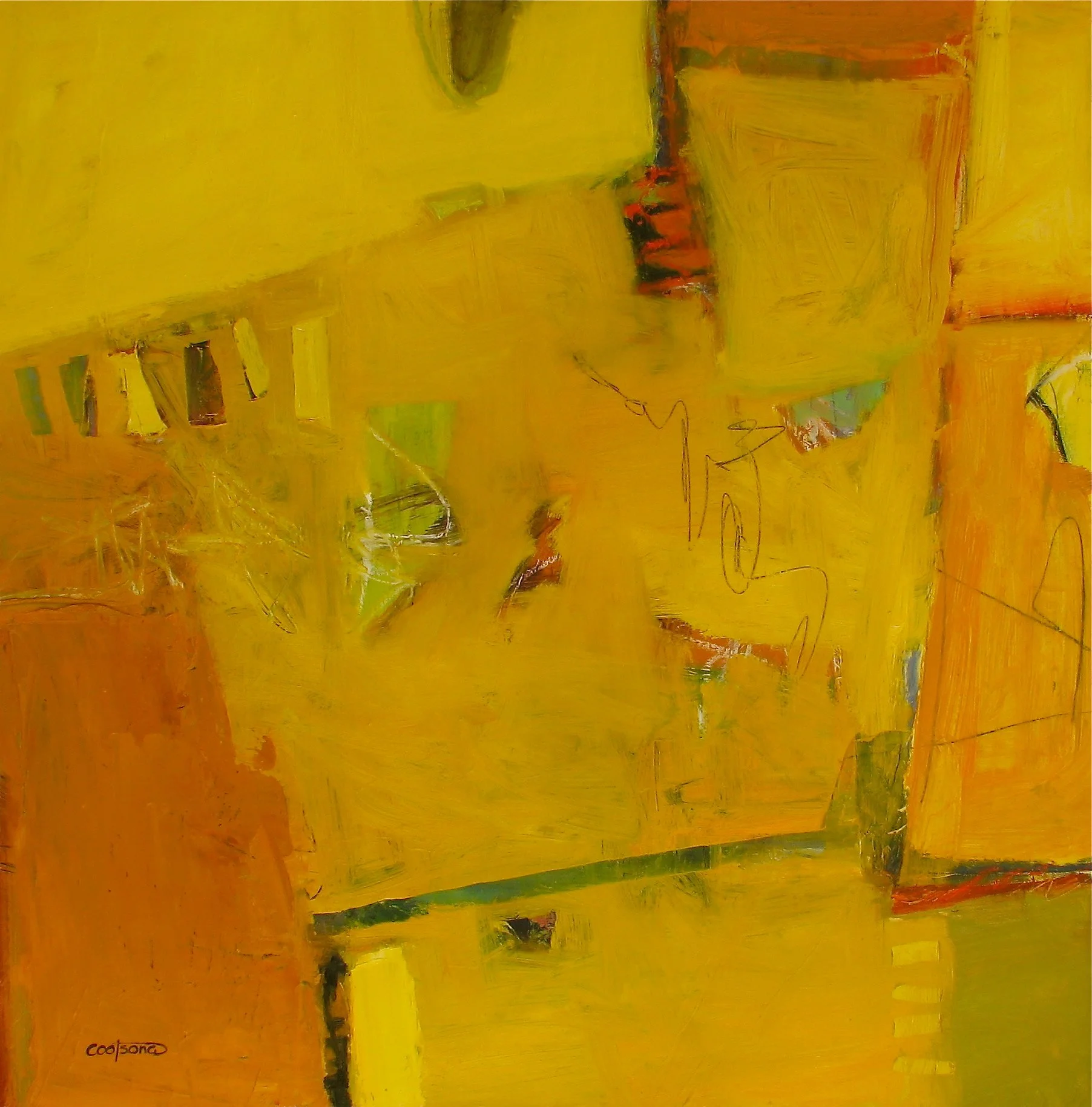colorwise
INTRODUCTION
ColorWise: Mastering Harmonious Color
Welcome! Bienvenue! Willkommen!
Quick Review of Color Terms
I use these terms throughout this course and want to make certain that you understand them.
-
Basically a color family such as Red, Blue, Yellow, Green, Violet, and Orange. We can break these down further into Yellow-Green, Red-Orange, etc. Every color belongs to a color family, thus, every color has a “hue.”
-
The brightness or INTENSITY of a color. We also sometimes use the word SATURATED. Cadmium Red Light (for instance) straight from the tube is an example of high-chroma, saturated color. A low chroma color is generally a more NEUTRAL color such as a grey or earth tone color.
-
Degree of lightness or darkness of a color. The color (hue) is not important in this definition, only how light or dark the color is relative to white and black. (Think of a black and white photo of your painting).
-
The true color of an object, as opposed to the way it may appear in certain lighting conditions, at a distance, or in contrast with other colors.
-
When two (or more) objects are near each other, the color of each may be reflected on the other. Imagine an orange next to a white pitcher. The side of the pitcher may take on (reflect) some of the orange color.
-
Every color is either WARM or COOL. This can be confusing to new painters in particular because color can be in a warm hue family but be cool relative to another color in their family. For example, Quinachridone Red is in the family of Red (warm) but it is a cool color relative to Cadmium Red Light.
See color temperature charts on GAMBLIN website below.
-
Colors opposite each other on the color wheel.
-
Three to four colors next to each other on the color wheel. Another way to darken or lighten a color is to add an analogous color.
In case you want to review it, below is a direct link to the materials list for this course.
PAINT COLOR TEMPERATURE CHARTS
To find the color temperature of most paint colors click on the button below.
NOTE: Color temperature holds true for acrylic and oil paint.
The Color Wheel
Having a color wheel in your studio can actually be super helpful. Watch this short video to see a trick that I do with this very popular and readily available version of the color wheel. This trick makes using and referencing the wheel so much easier!
Lesson one
FOCUSING YOUR COLOR CHOICES
Create Limitations in Your Color Choices and Open Your World to New Possibilities
MONOCHROMATIC and COMPLEMENTARY Color Palettes
MONOCHROMATIC PALETTE: uses one HUE and its combinations such as adding white (a tint) or black (a shade) or other colors to neutralize the original hue.
COMPLEMENTARY PALETTE: focuses on colors that are directly opposite each other on the color wheel.
I’m sure that many of you are familiar with these two color palettes, and they may seem very basic, but do you know just how versatile they can be? Working with these very limited palettes can not only strengthen your color knowledge but also produce some rich, rewarding paintings. Let’s look at some artists who create unique, dramatic and rich paintings using these limited palettes.
▸ PASSWORD: COLOR
▸ VIDEO LENGTH: 13:51 minutes
MONOCHROMATIC Palette Gallery
Click on any image to view larger.
COMPLEMENTARY Palette Gallery
Click on any image to view larger.
Important Color Concepts to Remember
All of these concepts can have a big impact in the overall feeling and mood of your limited palette painting.
✶ VALUE
Look at the very dark reds of the Mark Daily Monochromatic in contrast to the Patrick Lee pale reds and how VWLU can significantly change the feel of the painting.
✶ CHROMA
Look at the high chroma (intense/saturated) colors of the Raimond Staprans red and green in comparison to the muted reds and greens of the Wolf Kahn forest in the Complementary Gallery. The chroma creates a completely different mood in each.
✶ COLOR PROPORTIONS MATTER
A complementary painting in yellows and violets, for example, will have a very different feel when predominantly yellow then it will when predominantly violet. See Raymonds Staprans and Patrick Lee in the Complementary Gallery
✶ NEUTRALS MATTER
Neutrals can be included in these two palettes (as in most), and their values and proportions can also shift the feel of the work.
Project One: ONE SUBJECT, ONE PALETTE, TWO PAINTINGS
Watch me create two very different moods with the same image by changing the chroma (color intensity) in each painting.
Red/Green Complementary Palette:
HIGH Chroma · SATURATED Color
▸ PASSWORD: CHROMA1
▸ VIDEO LENGTH: 18:37 minutes
High Chroma Complementary Palette Red/Green
Red/Green Complementary Palette:
LOW Chroma · DE-SATURATED Color
▸ PASSWORD: CHROMA2
▸ VIDEO LENGTH: 15:25 minutes
Low Chroma Complementary Palette Red/Green
Red/Green COMPLEMENTARY Palette
-
Colors listed below (left to right)
Ultramarine Blue
Viridian Green
Permanent Green Light
Yellow Green
Olive Green
Quinacridone Red
Cadmium Red Light
Transparent Red Oxide
Yellow Orange
Cadmium Yellow Medium
Titanium White
Carbon BlackI later added:
Gamblin’s Portland Warm Grey
Gold Ochre
Gamblin’s Gel MediumThe panels had an initial acrylic layer of:
Burnt Sienna
Quinacridone Magenta
Your Turn:
Before beginning this project, read the section below on MINERAL vs. MODERN colors/pigments. After filming this demo I realized that having a firm understanding of the difference between the two will help with this project.
✶ Using either a Monochromatic or Complementary Palette, create two paintings of the same (or similar) subject matter using the same palette. I used a Red/Green complementary palette, however feel free to use any monochromatic or complementary palette of your choice. I have listed the colors I used for your reference but they are certainly not required.
✶ One painting will have more chromatic and “brighter” colors. You may still use neutrals here but color will be more dominantly high chroma.
✶ The second painting is to be more muted with low chroma colors. A more muted palette implies more neutral colors. Note that adding white (in acrylics and oils) will generally dull your colors as well (except with some modern pigments such as Pthalo and Quinacridone which retain their high chroma).
MINERAL VS MODERN PIGMENTS: What’s the story?
MINERAL COLORS
Made from pigments of earth and metals. The first first of these earth pigments go back to cave drawings. These earth pigments include colors such as Yellow Ochre, Raw Umber, and Venetian Red. Metal pigments were developed during the Industrial Revolution and gave the Impressionists a new palette to work with. Metal pigments include colors like the Cadmiums, Cobalts and Ultramarine Blue.
MODERN COLORS
Developed at the end of the 1800’s with the creation of organic chemistry and pharmaceutical dyes. Modern pigments are made in laboratories and are known for their transparency and very strong tinting strength. They tend to have long odd names like Quinacridone and Phthalocyanine.
Note on ACRYLIC PAINTS
Developed in the 1940s with it becoming available to artists in the 1950’s. These same concepts of tinting strength hold true for acrylic paint as well. Acrylic paints also have far more pre-mixed colors available.
✶✶ IMPORTANT TAKE AWAY ✶✶
Modern Colors have a high tinting strength. This means that when you add white to them (creating a tint) the color stays relatively saturated and bright, or High Chroma. Alternatively, Mineral Colors have a lower tinting strength and when white is added the color dulls and becomes significantly less saturated, or Low Chroma.
GAMBLIN COLOR CHARTS
This PDF shows the different colors of paints from different eras
✶ Classic = MINERAL Colors
✶ Impressionist = MINERAL Colors
✶ 20th Century = MODERN Colors
Click on the button below to view/download this useful color chart.
Want to learn more about the history of paint colors?
Gamblin is the industry expert and shares some great information on their website.
Artist Focus
〰️
RAIMONDS STAPRANS
〰️
Artist Focus 〰️ RAIMONDS STAPRANS 〰️
You’ve seen several of his paintings on this page, Staprans was an amazing master colorist whose color work was brilliant and the results are stunning. His colors look quite saturated at first glance, but if you study his paintings you will see the subtle manipulations of chroma from more muted colors to the high intensity colors. We can learn much from looking at his work. He did have quite an involved process which you can glimpse in this short video where he discusses his creation of blues. There are several more videos on YouTube if you are interested in more of his thoughts. (Fun side note: I was at the talk at the Crocker Museum (on YouTube) where I got him to autograph his book!).
Raimonds Staprans Museum Show
Click on any image to see larger.
It’s always exciting to meet one of your creative “heroes” and see their work on display.
Working in a Series
A series should have visual continuity. The work should “hang together” but not be so repetitive as to be boring.
Click on any image to view larger.
-
I highly recommend that you focus on working in a series, and this course is the perfect time to do it! There are different approaches to working in a series. When I find a gesture or pose that I particularly like in my figurative work, I will re-use it many times in different paintings as you can see in the examples here. This allows me to explore different environments for the figure and then create different moods and emotions while repeating a figure that becomes more familiar with each painting.
-
The important part about a series is that you focus on a concept and explore it for a period of time. Creating a series gives you an intention in your work and also a nice limitation as it narrows down “what you will paint” or your subject matter. It will force you to explore different expressions of your concept, and typically leads to growth in your work.
-
Choose a specific visual theme to explore. This can be very specific or more broad in scope. A few examples would be:
✶ A landscape that you regularly see, such as “Mountains and Sky” or a lake in different seasons or light. It also can be more focused like a singular tree. Monet’s haystacks are an example of this idea.
✶ An item that intrigues you such as a chair in different light or even a series of chairs. A favorite room, flower or flowers, plant or still life.
✶ Think about intimacy of the subject. Remember you can zoom in and zoom out. The closer the subject the more intimate the painting.Choose one or two of the Five Elements of Design to explore.
✶ Explore color with a singular subject matter
✶ A series on texture or pattern for example. These may relate to your medium. Texture with oil and cold wax make a great subject to explore. Pattern and collage with acrylics are a natural combination.Choose a more conceptual topic to explore. This can be a bit hard to define and I recommend it be as specific as possible. Vague concepts are challenging and don’t often work well, such as painting “love” or another emotion. Try to narrow your topic down and to give yourself a framework. Below is an example of a series of mine called Keystone. I am essentially working with geometric shapes and color as puzzle pieces that must fit together in an interesting composition.
-
Additionally, a series is a great way to study color! Staying with one theme, subject matter or topic and exploring different palettes is a perfect way to learn how color affects an image!
Keystone Series
“These paintings speak to my roots in architecture and puzzle solving. Each painting is built with layers of color, texture and an exploration of shapes. Like removing the ‘keystone’ in an arch, one color or shape change can affect the whole painting. The fun is in finding just the right balance of each element.”
Click on any image to view larger.
Project Two: WHO IS THE STAR?
Looking at Color Proportions
Experiment with which color gets the spotlight, and open the door to powerful new ways to tell your story.
In this fun project we play around with color proportion in some freeing abstract paintings. This is one to get your creativity flowing and really play with color before we move on to the next section. These two short videos illustrate how using the exact same palette but changing the color proportion can change the feel of your painting. Doing this as an abstract can keep you in a playful mode, but feel free to do it with realist subject matter if you prefer.
demo1: Blue/Red Orange Complementary Palette
▸ PASSWORD:STAR1
▸ VIDEO LENGTH: 13:28 minutes
Blue/Red Orange COMPLEMENTARY Palette
-
Colors listed below (left to right)
Ultramarine Blue
Cerulean Blue Hue
Provence Blue
Cadmium Red Light
Cadmium Orange
Cadmium Yellow
Titanium White
Transparent Red Oxide (for the initial wash)
Pthalo Turquoise (for the initial wash)
demo 2: Analogous Palette of Yellow to Red Using Neutrals
▸ PASSWORD:STAR2
▸ VIDEO LENGTH: 11:53 minutes
Analogous Palette of Yellow to Red Using Neutrals
-
Colors listed below (left to right)
Burnt Sienna
Transparent Red Oxide
Transparent Orange
Cadmium Orange
Cadmium Yellow
Titanium White
Van Dyke Brown (a warm black)
lesson two
COLOR and VALUE
Understanding the relationship of Color and Value is KEY to understanding Color and Harmony.
Let’s review the definition of VALUE and some important related terms. We will see in this section why VALUE is such an important player in Color Harmony.
VALUE is the degree of lightness or darkness of a color. The color (hue) is not important in this definition, only how light or dark the color is relative to white and black. (Think of a black and white photo of your painting).
A MID-VALUE PAINTING is a painting created with colors in the mid-range of the value scale which would be approximately 4 - 7 as seen here on the “value finder.”
A HIGH KEY PAINTING is a painting created with mostly light values (towards number 10/white) which would be approximately 7-10.
A LOW KEY PAINTING is a painting created with mostly dark values (towards number 1/black) which would be approximately 1-4.
The value scale shown here can be a helpful tool to help you learn the value of your colors. NOTE: Sometimes you will see this scale reversed with 1 as White and 10 as Black. Be sure to notice which method is being used.
Project Three: SPARK IT!
Creating Color Charts to Learn Values
Painting color charts to learn to see your values is an “invaluable” exercise (pun intended). Even making just a few of these will help refine your color skills. Like practicing scales on the piano, color charts can be a “valuable” discipline.
There are several different ways to make color charts. The charts in this video focus on seeing each color’s corresponding value and also on potentially finding some new color combinations.
▸ PASSWORD: Chart
▸ VIDEO LENGTH: 10:05 minutes
Your Turn:
I encourage you to use several color combinations that you don’t typically mix together when creating your chart.
-
Colors listed below (top to bottom)
Carbon Black ▪ Titanium WhiteRaw Umber ▪ Cadmium Yellow Medium ▪ Titanium White
Van Dyke Brown ▪ Quinacridone Red ▪ Titanium White
Carbon Black ▪ Ultramarine Blue ▪ Titanium White
Alternative Color Charts
For those of you who struggle with “Staying Within the Lines” and find charts way too tedious, here is an alternative. Select two or three colors plus white and black and explore the palette in a sketchbook or whatever format works for you. Here are some examples from Julia Foug who created these color studies in her sketchbook. She both learned how the colors mix and now has a reference to look back on for color inspiration in future paintings!
Be sure to write down what colors you use!
HOW WE GOT TO NOW
〰️
HOW WE GOT TO NOW 〰️
A Little History of Expressive Color in Paintings
This is a short and VERY simplified history in pictures of how we went from the neutrals of Carravagio and Rembrandt to contemporary expressive color in Western Art.
▸ PASSWORD: HISTORY
▸ VIDEO LENGTH: 22:00 minutes
Project Four: THE ART OF SEEING VALUE
Learning to see the value of your colors is extremely important in understanding color and harmony. These are two fun stress-free projects that will help you learn this important skill.
PART 1
▸ PASSWORD: TREE
▸ VIDEO LENGTH: 10:34 minutes
PART 2
▸ PASSWORD: FACE
▸ VIDEO LENGTH: 9:04 minutes
Your Turn:
Use my black and white photos below or choose your own.
Choose a photo with a wide range of values.
It can help to spray the photo with fixative so that the ink will not bleed into your paint color.
Try to match the value of each grey with your paint colors.
You may want to print out a second photo for reference.
Try using expressive colors!! Let your brushwork be loose.
NOTE: If you have previously done a similar project in Own Your Colors 1, then sketch and paint this on a canvas (or other substrate) instead of directly on top of a photograph.
Reimagine How We Use VALUE
Using Limited Values to Create Color Harmony
Now that we have a firm understanding of Value and Color and their relationship, let’s look at different approaches to how we can use Value in our work to create color harmony.
▸ PASSWORD: VALUE1
▸ VIDEO LENGTH: 13:00 minutes
DEMO
〰️
DEMO 〰️
“Stealing” an Artist’s Palette
In this next demo I refer to a Wolf Kahn painting for color inspiration. Kahn is our featured artist in this section and he had a brilliant color sense. Scroll a bit further down to see his Artist Focus. I have several Wolf Kahn books which are well earmarked with notes on his color choices.
I highly recommend “stealing” the palette of a painting which inspires you. There is much to learn from working with another artist’s successful palette. You will learn how to mix those colors and often how they harmonize. You will learn how to pay attention to those crucial concepts of Chroma, Value, and Proportion.
You will also find that your painting will, most likely, come out with at least some different colors than the original source. Mine certainly did. This is a good thing. You will learn to see if those colors work within your painting or if they do not, and you will improve your color-choice decisions.
By working with another artist’s palette, you will begin to understand the original artist’s color journey as well.
Project Five: “STEAL” A PALETTE
A HIGH KEY Painting Inspired by Wolf Kahn
This video is broken into two parts for ease of downloading and watching.
PART 1
▸ PASSWORD: STEAL1
▸ VIDEO LENGTH: 20:12 minutes
PART 2
▸ PASSWORD: STEAL2
▸ VIDEO LENGTH: 14:20 minutes
Your Turn:
Choose a HIGH KEY Wolf Kahn painting or a different artist’s work whose high key color palette inspires you. Use my barn photo or create a painting with your own subject matter, using the colors/palette of your inspirational painting. (Remember HIGH KEY = values on the lighter end of the value scale).
Pay attention to any neutral colors in the work and how these neutrals may support the more saturated colors.
Pay attention to color proportions. Are you using similar proportions or are you changing them? How does this affect the painting?
Are your values close together? It is perfectly OK to have a few dark values within a HIGH KEY painting.
Your palette colors will most likely not match exactly, and that is perfectly OK.
“Pink Barn” Demo Palette Colors
-
Colors listed below (left to right)
Ultramarine Blue
Yellow Green
Quinacridone Red
Cadmium Red Light
Cadmium Orange
Cadmium Yellow Medium
Cadmium Yellow Light
Titanium WhiteBuff Titanium
Provence Blue
Blue Grey
Portland Warm Grey
Portland Cool GreyCold Wax Medium
Artist Focus
〰️
WOLF KAHN
〰️
Artist Focus 〰️ WOLF KAHN 〰️
Wolf Kahn was a brilliant, well loved colorist and landscape painter. This video shows several of his pastel paintings with a reading of Kahn’s own words describing his thoughts on art and his work. If you are interested in watching him actually speak go to YouTube where there are several videos, however, they are all rather poorly produced. I have included the link to one that I found the most interesting and amusing below.
“Colors should never be allowed to merge too easily into their surroundings. If a color drowns in the totality, it loses its energy: it might not have been used at all. Like a good guest at a dinner party, a color should participate in the occasion but must not be allowed to take over the conversation to the point where other guests, who also wish to participate, are squelched, and cannot be heard.”
A great book for your library with dozens of beautiful images for your reference.
Click on image to see full painting
What is a Notan and how can it help me?
The word Notan is derived from the Japanese word Nong, which means strong, thick, or concentrated, and the word Dan, which means weak. A Notan painting has only two, three or four values. Notan paintings and studies can create a balanced and harmonious work using this simple concept of contrast and opposites.
NOTAN FACES
Using the concept of a Notan is a great way to abstract faces. Learning to see the important planes of faces by reducing values can truly help you to simplify your work. The painting in the following demo is made up of four values which give you a good likeness, yet little detail.
NOTAN FIGURES
Notans are used in all kinds of subject matter from pure abstract to landscape and figurative. Limiting your values can create some very dramatic effects. Reduicng the value in your figures will help you to see the important shapes and forms.
NOTAN BACKGROUNDS
Creating a Notan from a photo can immediately abstract the “background” areas surrounding your figure. Using this tool can give you a jump start on ideas for your ‘backgrounds.”
COOL TOOL
〰️
COOL TOOL 〰️
NOTANIZER APPLICATION
Fortunately for us there is this super cool APP, available in both Apple and Android versions, called Notanizer. You can upload any photo into the App and it will reduce it to how ever many values you choose. Personally, I like the selection of 4 Values.
There are many examples if you do some searching to see what you can do—or of course, just get the app and experiment on your own!
Project Six: PAINTING A NOTAN
In this fun project I used an image from “UnSplash",” a royalty free website. It looks like Liv Tyler to me! I uploaded the black and white photo into the Notanizer App and selected 4 values. I used Ultramarine Blue, a touch of black and Titanium White to create four blue values and then painted the image.
▸ PASSWORD: NOTAN
▸ VIDEO LENGTH: 19:40 minutes
Your Turn:
Create a Notan of three to four values. Faces are fun because this project helps you to learn the shapes of the face. If you prefer a different subject matter, that is ok too!
Start with a monochromatic version of one color plus white, and black to get your “black value.”.
For a more advanced version select several colors but continue to match the values of the Notan.
Have fun!
lesson three
THE MAGICAL WORLD OF TRIADS
Creating harmonious, rich paintings with three colors.
It sounds so simple and basic, but working with variations of the primary colors Yellow, Red and Blue can not only limit your color choices but will give you guaranteed color harmony. Working with secondary colors and other Triads will also keep your colors harmonized. There are actually many primary color combinations and some that you may not have even thought of.
Let’s start by looking at a few here:
⇣ LOW CHROMA, LOW INTENSITY PALETTES ⇣
⇣ HIGH CHROMA, HIGH INTENSITY PALETTES ⇣
Your Turn:
Click on the icon below to download a blank chart of the color circle wheel above, to create your own color wheels.
Project Seven: FUN COLOR WHEEL PROJECT
All of the secondary and tertiary colors on the wheels above were mixed from the three primaries. As you can see the palettes are all quite different and they all create lovely color harmonies. I’ve included a PDF of this wheel here so that you can print it out and make your own combinations. These are actually quite fun to paint, and can yield surprising results.
Another good combination is Gold Ochre, Cadmium Red Light and Black or Payne’s Grey. (This is the Zorn Palette which we will look at a bit more later.)
Remember, some of your earth tones can count as primaries, for example: Raw Sienna = Yellow, Payne’s Grey = Blue, Burnt Sienna = Red
Other ideas: you can substitute Black for Blue with different results.
I added white to a few of the very dark colors otherwise they are too dark to discern.
I did not have Hansa Yellow for the Modern Palette which would be more appropriate as it is more transparent than the Cadmium.
Notice if your color choices are opaque or transparent as that makes a difference in the brilliance of the colors.
Project Eight: PAINT WITH PRIMARY TRIADS
Watch me use two different triads plus black and white to create two different paintings with the same subject matter. In the first painting I use the Semi-Opaque Triad which creates a low chroma painting. In the second demo, I use the Traditional Triad which creates higher chroma results.
▸ PASSWORD: TRIADS2
▸ VIDEO LENGTH: 24:49 minutes
Your Turn:
Choose two of the primary triads above, or have fun creating one of your own using the paint colors in your studio. Feel free to use the same Richard Diebenkorn reference photo or any image of your own. Your subject matter does NOT need to be a portrait or figurative.
Things to Remember:
It’s great to choose a relatively easy image for this Project so that you can do it quickly and create at least two paintings. This way you will get an immediate sense of what these primary triad colors can do.
Remember, you can add black and white.
Notice if your colors are opaque or transparent.
Any Pthalo will tend to overpower the painting so use caution with Pthalos. (ie. Use small amounts of Pthalo.)
DID YOU KNOW?
〰️
DID YOU KNOW? 〰️
Triads Create the Best Skin Tones?
Let’s take a quick look at several palettes that mix together to create beautiful skin tones of any race.
▸ PASSWORD: SKIN
▸ VIDEO LENGTH: 10:29 minutes
⇣ These colors were mixed together on a neutral grey palette ⇣
WHAT’S THE STORY?
〰️
WHAT’S THE STORY? 〰️
Student Grade vs. Professional Grade Oil Colors
⇣ Each color below has the same amount of white added. ⇣
You can see that the Professional pigments are stronger than the Student Grade pigments.
Just A Bit More on Chroma
Controlling chroma is how painters create that glow that you see in some paintings. This is done by placing high chroma colors next to neutral colors.
Refer to these two examples where CHROMA, VALUE and PAINT TRANSPARENCY were all used intentionally to create the feeling of light in the paintings. (Yes, that candle painting is a painting not a photo!) In the next demo, we will look at another type of triad and also concentrate a bit more on chroma.
Project Nine: A TRIAD USING SECONDARY COLORS & ANOTHER LOOK AT CHROMA
In this demo, I paint a still life of orange fruit. I’m not quite as masterful with the details that Adam Clague is above, but you can see the process. I use a triad of Orange, Green and Violet, but I use lots of colors to create this triad. I’m also very focused on Chroma and creating light and shadow on the subject matter.
▸ PASSWORD: ORANGE
▸ VIDEO LENGTH: 18:49 minutes
Demo Palette Colors
-
Colors listed below (left to right)
Ultramarine Violet
Ultramarine Blue
Cerulean Blue
Quinacridone Red
Cadmium Red Light
Cadmium Orange
Cadmium Yellow Medium
Cadmium Yellow Light
Titanium White
Titanium Buff
Gold Ochre
Carbon Black
Your Turn:
Create a painting choosing either a secondary triad or another triad of your choice. Look back at the color wheel in the introduction if you need a reminder on how to find your triads. Feel free to use my source image if it interests you.
If you are working with a high Chroma image pay attention to your brush and keep it relatively clean so that your bright colors stay “clean” and do not get contaminated.
To keep high Chroma colors bright, avoid adding white until absolutely necessary. Try using a lighter analogous color first, before you add white. White will cool and dull your colors.
Look for reflected colors.
Pay attention to your values.
Mix the colors in the triad to create beautiful neutrals.
“Both my printed image of this source photo and the actual orange were slightly more red-orange than this photo, thus my slant towards a more red-orange in the painting. If you are painting a still life, it is always best to paint it from life if at all possible.”
Artist Focus
〰️
EDMOND PRAYBE
Artist Focus 〰️ EDMOND PRAYBE
“I use the still life genre as a vehicle to pair intense direct observation with an underpinning of abstract structure, rhythm, shape and color. I am equally interested in translating the observable world into paint, developing carefully arranged divisions of surface geometry and exploring abstract color relationships.”
Praybe lives in Maryland and shows his work at the galleries listed below. He is a great draftsman (he knows how to draw!) but he also has a brilliant and sublime color sense. In this gallery of images, notice how he is incorporating everything we are learning about color harmony in different paintings: limited palettes, closely related values, triads, monochromatic palettes, complementary palettes, etc. He also very consciously manipulates Chroma by placing his brighter colors where he wants to “draw our eye.” There is a lot to be learned by studying his work!
Look at Praybe’s work and see if you can find the color theories that you have been learning about!
Click on any image to see larger.
⇣ To see more of EDMOND PRAYBE’S work, visit the sites below. ⇣
lesson four
KNOWLEDGE TO INTUITION
Color Theory is the Grammar. Your Intuition Creates the Poetry.
“Color is the alphabet to your painting novel. Understanding color theory will lead you to work more intuitively just like learning to read and write will free your imagination to create your poem or novel. ”
The Symbolism of Colors
Let’s take a moment to look at the symbolism and emotional qualities of the primary and secondary colors. When working more intuitively with color, it is good to know how it might be interpreted. I have tried to include a wide range of styles, artists, and color variations to inspire you in the color gallery collections. I’ve also included links to short histories of each color for those of you who are interested in more detail. Click on any photo to see a the full image.
Learn More About Colors
〰️
Visit MY MODERN MET
〰️
Learn More About Colors 〰️ Visit MY MODERN MET 〰️
About the Color RED
RED
Red is one of the first colors used by man and can be seen in Paleolithic cave paintings. It’s emotional qualities are often thought of as passion, anger, vitality, love, danger, blood. It has also been used to represent wealth and has had several symbolic meanings in religious paintings.
About the Color BLUE
BLUE
Egyptians were the first people to create the color Blue in pigment. Blue has been associated with calm, serenity, infinity, spirituality, water, sky, cool or cold, sadness. When blue pigment was made from lapis lazuli, it was worth more than gold, thus it has also been used to represent wealth and has had religious connotations.
About the Color YELLOW
YELLOW
Yellow is also one of the oldest pigments in the form of Yellow Ochre. It has been found in cave paintings as well as Egyptian and Roman art. Yellow has quite a few emotional and historical connotations. Several of the positive ones are, sunshine, warmth, optimism, joy, energy, intellect. Conversely, Judas is often depicted wearing yellow as it also symbolizes cowardice and deceit.
About the Color YELLOW
ORANGE
The color Orange is often associated with excitement, warmth, amusement, and energy. It can also signify danger or caution when used to catch our eye in potentially dangerous situations (think safety vests and inmate’s jumpsuits). It has religious connotations particularly in the East with Buddhism and Hinduism. It can also denote the Autumn and the changing of seasons.
About the Color GREEN
GREEN
Green is known for many symbolic qualities such as nature, growth, renewal (think Spring season), wealth, vitality, and youth. More negatively it can be associated with envy and illness, and when de-saturated and used in interiors it can create an eerie effect.
About the Color VIOLET/PURPLE
VIOLET/PURPLE
A Violet or Purple pigment dates back to prehistoric times and cave paintings. The Ancient Phoenicians later discovered a new method to make Violet by using thousands of sea snail shells which was an extremely expensive and difficult process. Thus, only the very wealthy or royalty could afford to wear any clothing with purple dye and they (along with the Catholic Church) were also the only ones who could afford to commission paintings with the pigment. Purple can symbolize wisdom, power, spirituality, luxury, wealth and nobility. It has also been said that it can both stimulate your imagination and create calmness. Violet can also invoke a sense of mystery.
Color Temperature
One of the last important concepts of color theory that we have not yet reviewed is Color Temperature. Every color has a temperature that is either warm or cool and most colors have a cool and warm version. Gamblin has a great chart that shows the temperature of each of their paints. These color temperatures will hold true for other mediums, such as acrylics and watercolors.
In this next short video we look at some warm and cool versions of our colors. I also demonstrate different ways to cool your colors down and/or warm them up.
▸ PASSWORD: WARM1
▸ VIDEO LENGTH: 9:45 minutes
color temperature
RULES!
〰️
RULES!
〰️
RULES!
〰️
RULES! 〰️ RULES! 〰️ RULES! 〰️
COOTSONA
Know the rules…and learn how to break them!
Learn these Color Theory Rules to create a sense of depth or space in your paintings.
Warm colors come forward and cool colors recede.
Bright, high chroma colors, come forward and more neutral, low chroma colors, recede.
Dark values come forward and light values recede in landscape painting and as a very generalized rule.
In portraiture, light values come forward and darker values recede.
Harder, “found,” edges come forward and softer, “lost,” edges recede. (Not color theory, but important to know.)
In this painting you can see how depth of space is created by several of these rules:
Brighter and warmer colors come forward.
Cooler and duller colors go back in space and create a sense of depth in the painting.
Rule Breaking
Now let’s watch a video of several inspiring paintings where lots of rules are broken and the paintings are not only very successful but a bit unexpected!
▸ PASSWORD: Picasso
▸ VIDEO LENGTH: 6:24 minutes
Project Ten: A SENSE OF PLACE
In the photos below, the artist, Richard Diebenkorn, has tried to capture the sense of the place where he was living at the time. He would work in series and these particular abstracts were done in Berkeley, California and Albuquerque, New Mexico. You can see the color differences immediately. Berkeley has more vegetation, is cooler, and is close to the San Francisco Bay. Albuquerque has more open space with the desert surrounding it as well as the colors of sand, clay and the feeling of heat.
Here is a link to an interesting article regarding Diebenkorn’s process with these abstract paintings.
Click on any image to view larger.
Desert Colors Demo
In this demo I create an abstract painting while focusing on the colors of the Coachella Valley where I live. These are desert colors that I see in the land, mountains, flora and sky. The intention of this project is to evoke a sense of how the place looks and feels like purely abstractly with color, shape, line, value and texture.
▸ PASSWORD: DESERT
▸ VIDEO LENGTH: 20:48 minutes
Your Turn:
Focus on a place that you know well. If you choose to do an abstract, feel free to use photo reference reminders for color, shapes, value and line. Try to create your feeling and interpretation of that place by really focusing on color.
If you prefer to chose subject matter that is realist, think about interpreting the image in colors that might be unexpected and represent your feelings about the place. Try to capture the “Sense of Place” more than visual accuracy. If you work from a photo, try printing it in black and white so that you can create your own color palette.
Things to Remember:
All of the color concepts that we have learned in this course: Limitations, Value, Chroma, Color Proportions, Triads, Temperature, etc.
The “Rules” listed above. Be aware of them and if you are intentionally breaking them.
Can you create a sense of depth in your painting? Or, conversely, would you prefer to keep it flat?
Are you being expressive with your colors and not just copying a photo?
Desert Demo Colors
-
I know, I know, I used LOTS of colors! I knew the basic palette that I wanted in this painting and many of the colors are created by mixing so I needed several options. Also, when doing a demo, I like to have everything out to make things go as quickly as possible. You certainly don’t need this many colors out to create this project!
Colors used in demo (listed left to right):
Ultramarine Blue
Cerulean Blue
Viridian
Permanent Green Light
Quinacridone Red
Gold Ochre
Cad. Yellow Medium
Cad. Yellow Lemon
Titanium White
Titanium Buff
Radiant Turquoise
Portland Cool Grey
Portland Warm Grey
Neutral GreyCold Wax
Artist Focus
〰️
MICHAEL HEDGES
〰️
Artist Focus 〰️ MICHAEL HEDGES 〰️
“My paintings are a synthesis of color, line, form, and texture. They begin as a problem of two or more color relationships to be explored through form. The form is loosely defined by a drawing that acts as a skeleton and exoskeleton both beneath and above the finished work. The application of the media to the painting surface is of utmost importance to me. The paint is applied with great bursts of energy, creating a surface, if I am successful, that is supercharged with texture and color. ”
I think this is the perfect place to include a contemporary artist who works with abstraction and a sense of place! Michael clearly has a joy of color and uses it masterfully. Look here at his color combinations and limitations. He works in series and explores dozens of color options within each limited palette. He also names these series very specifically which gives us that sense of place, for example, “Country Living” and “Lakeside.”
Click on any image to see larger.
To see more of MICHAEL HEDGES’ work visit sites below:
MICHAEL HEDGES
“Country Living”
Here you can see Hedges’ studio full of multiple paintings of the series, “Country Living.” Truly exploring a palette like this can lead to new discoveries and a solid knowledge of what your colors can do!
Project Eleven: PAINTING YOUR EMOTIONS
Being able to express emotional content in your work is the goal of many painters. This video shows a wide variety of artists who draw on their emotions to create their subject matter. The paintings range from highly realist to purely abstract, but the intention of the artists to convey, often very strong, emotional content is consistent throughout.
▸ PASSWORD: FRIDA
▸ VIDEO LENGTH: 25:00 minutes
Your Turn:
Create a painting that expresses one or more emotions that are personal to you. As you have seen, this can be a pure abstract or it can be realist and with narrative. It can be challenging to be vulnerable and truly express our feelings, but often when we do, we create our best work.
Things to Remember:
Use color expressively. Think about it’s impact and meaning.
Remember all of the elements of design (Value, Color, Shape, Line, Texture) and how you might manipulate them and/or use them to your advantage.
“Listen to” and watch your painting. If it begins to move in a direction that you didn’t expect consider following that direction.
Some thoughts I had while painting “Honey:”
Warmth, sweet, sticky, summer, honey colors, the feel of the gooey texture of honey, the transparency of honey, the taste of honey….
“HONEY”. M. COOTSONA
Why Aren’t My Colors Working?
The problems I see most often when I look at student’s work and how to fix them.
As a final video in this course, I show three paintings that have color “problems,” and I walk you through my thought process of how to harmonize and improve the paintings.
Here are several key problems that I often see in work from people who struggle with color:
The number one problem of most paintings that have color “issues” is too many colors. When unsure of what color to use students will often add a new color to a fairly developed painting instead of staying with a variation of a color already in the painting.
Another common problem is too much high chroma or inconsistent chroma, areas that are either too bright or too dull.
Not enough neutrals are used. The painting is full of too many colors and no neutrals for contrast.
Color temperature is off. For instance, shadows are too cool when a warmer shadow would feel more natural and rich.
Lack of reflected light on objects. Reflected light can tie your whole painting together and make it cohesive. Always look hard for reflected light.
“I truly hope that you enjoyed the course and now have a better understanding of color harmony. Thank you for your continued support of my courses and teachings. Keep on Painting!”
For even MORE ideas on color, refer to my Essential courses:
The two Essential E-Courses shown below deal specifically with color theory and usage, and may be a great way to further deepen your understanding of color, and its many qualities. Hope you find them useful for your creative journey.
~Melinda
Recommended for all Online Self Study Course Students
A Monthlong Critique Session with Melinda Cootsona
This course is perfect for students who have created work independently and wish to move forward with their study. In this course, Melinda gives specific and individual comments on your work. Receive constructive and meaningful feedback to improve and progress your work, no matter your subject matter or experience.

